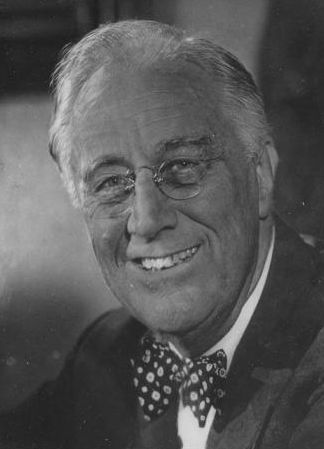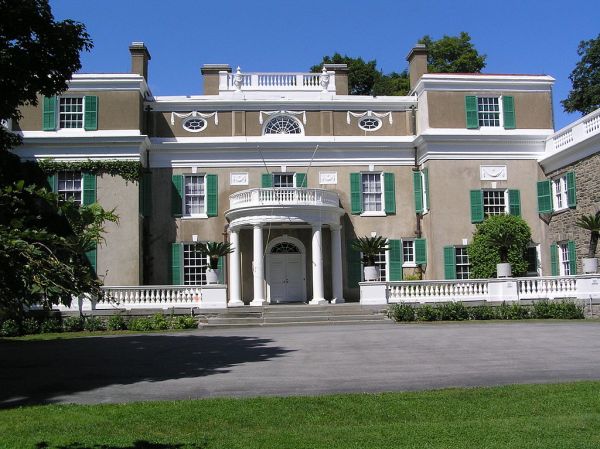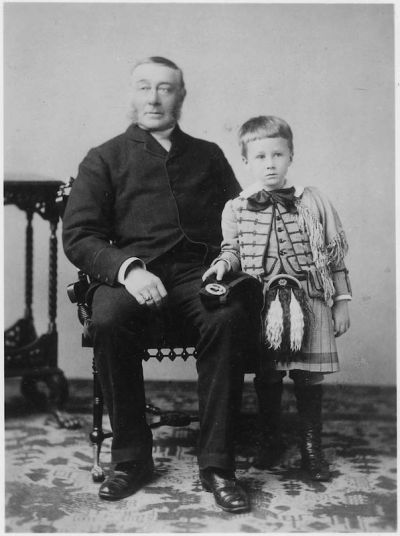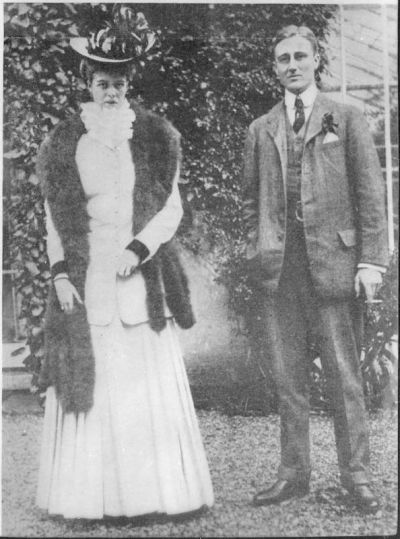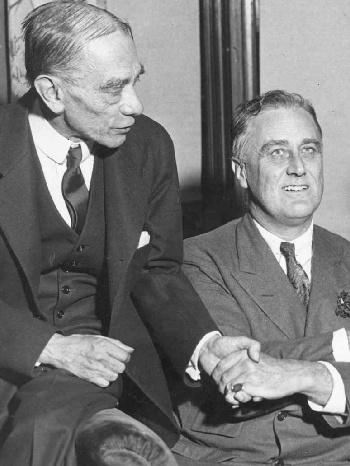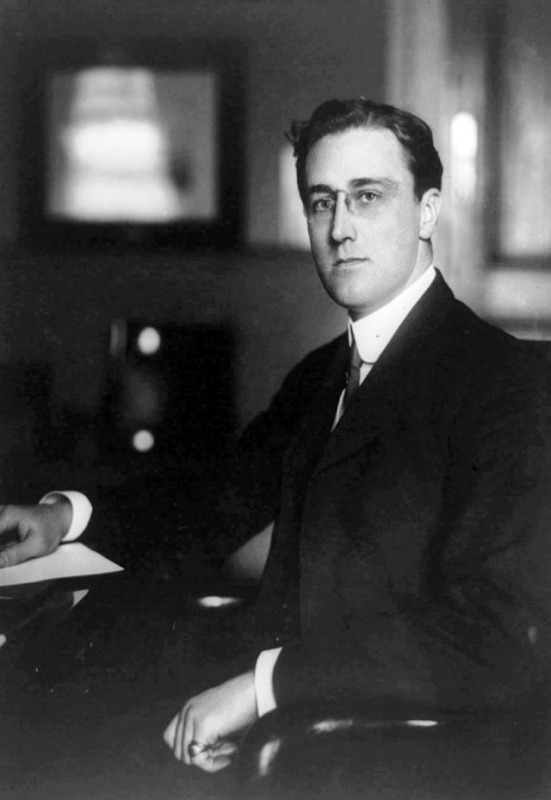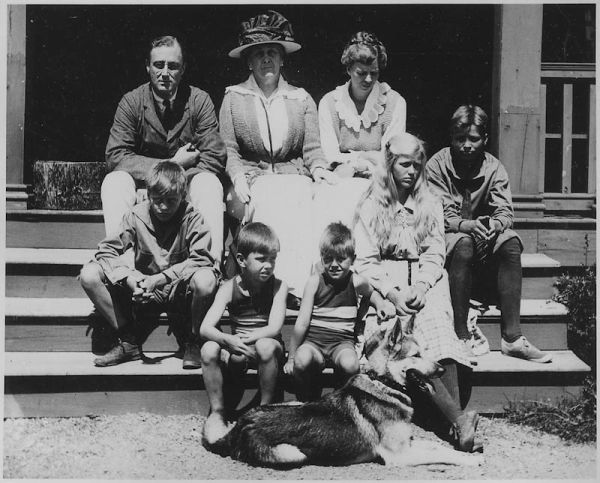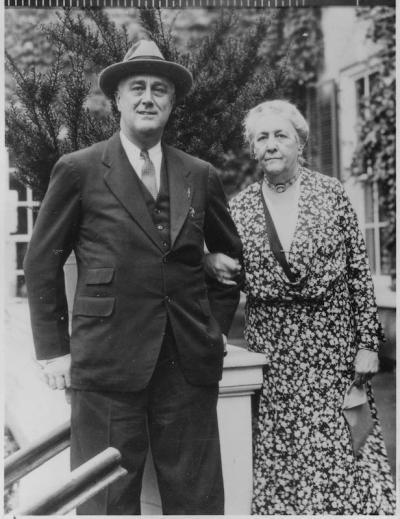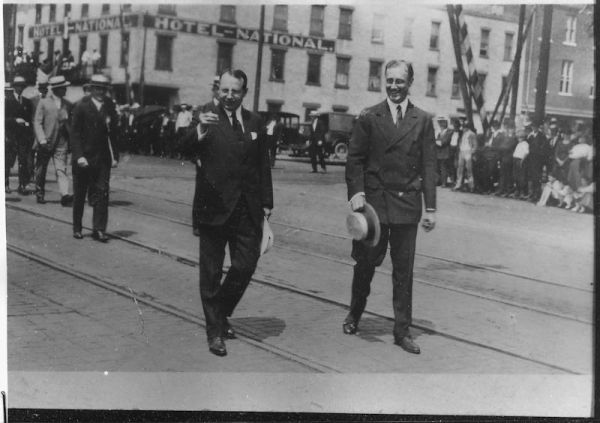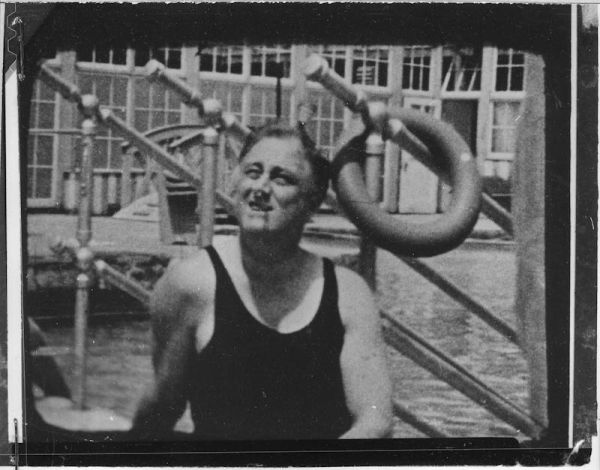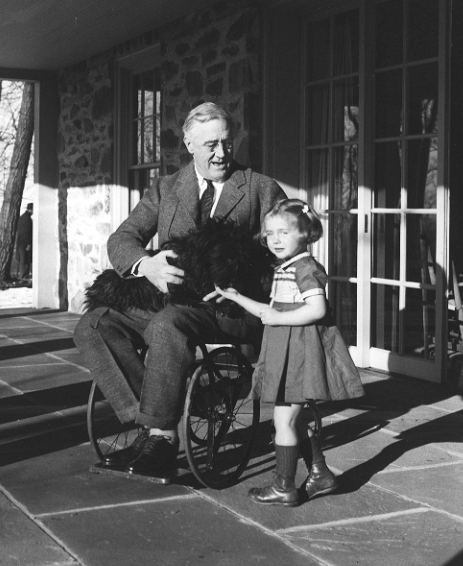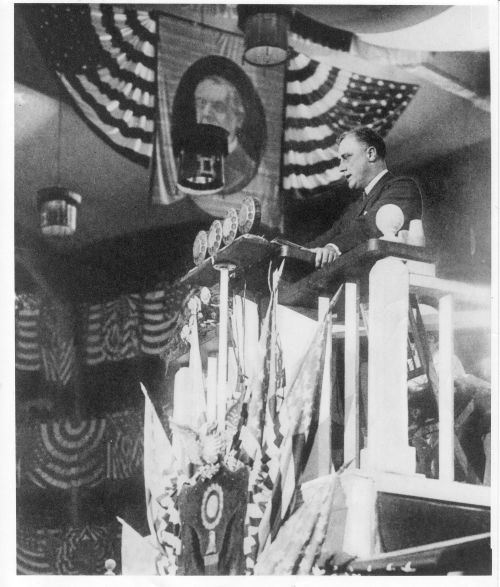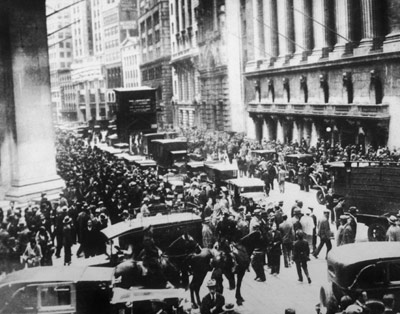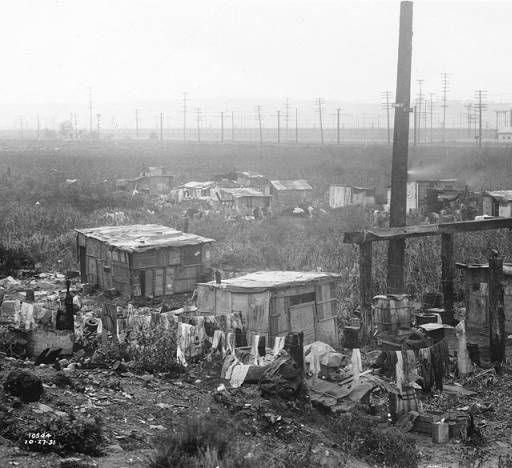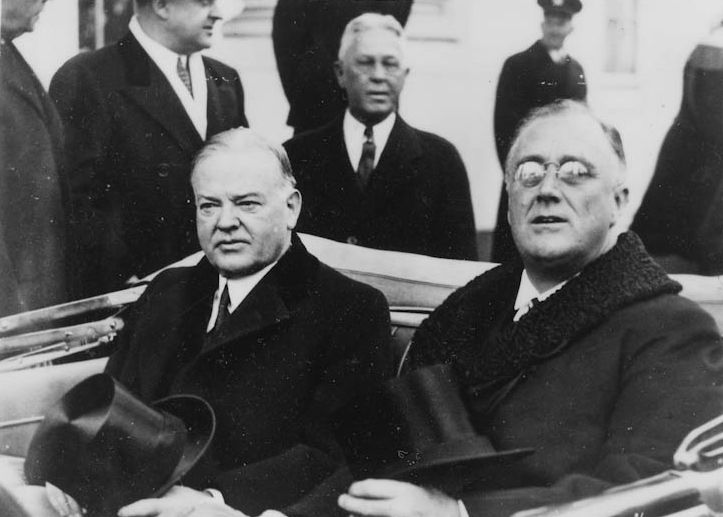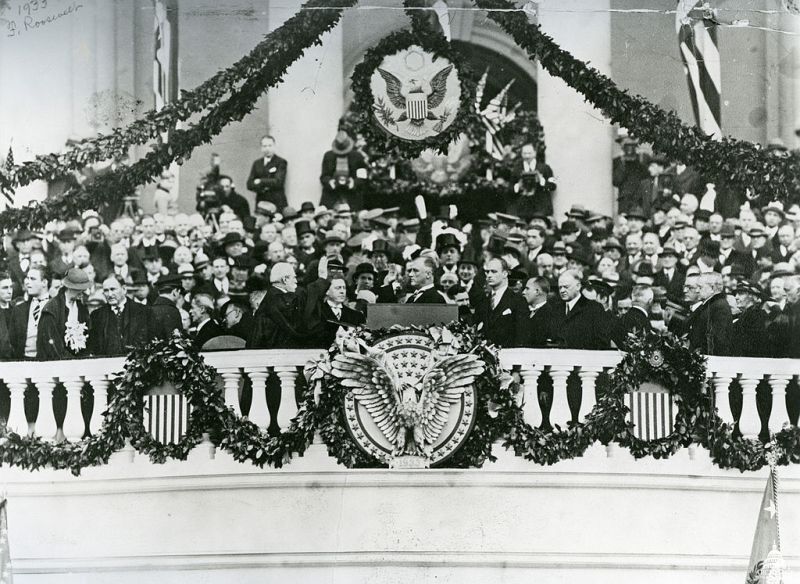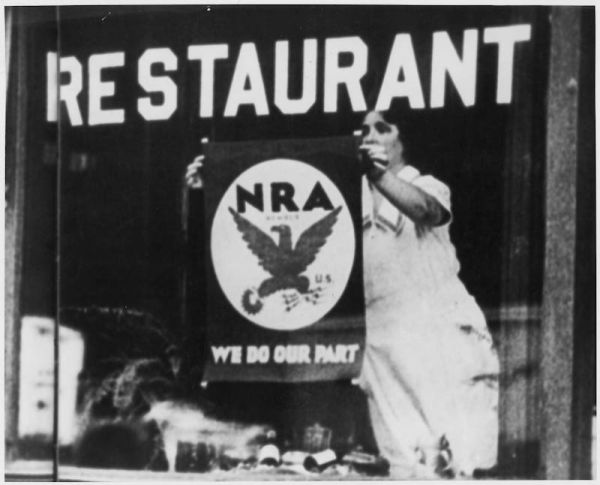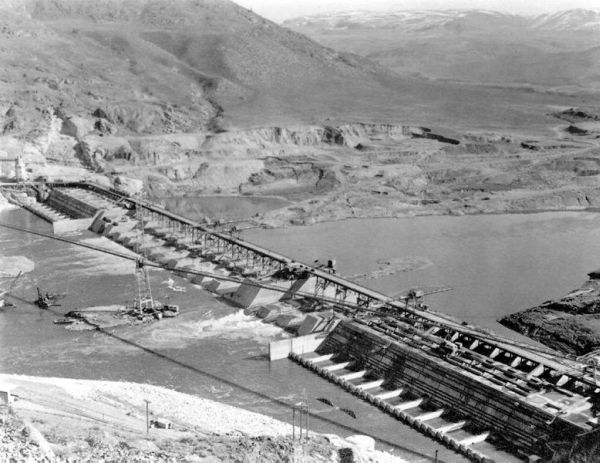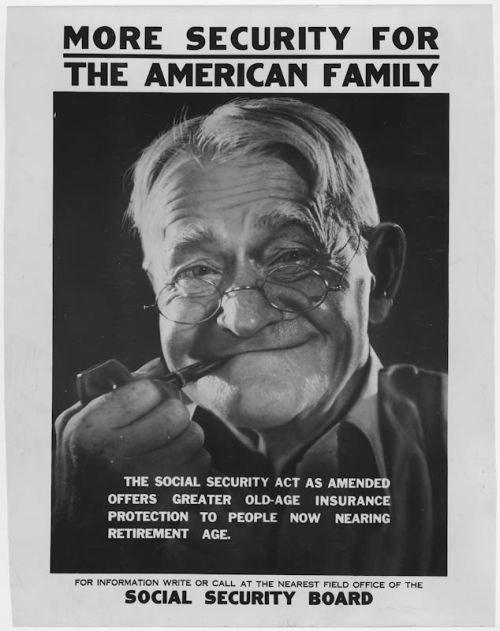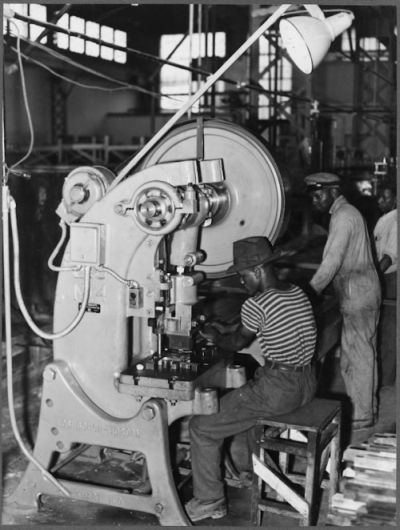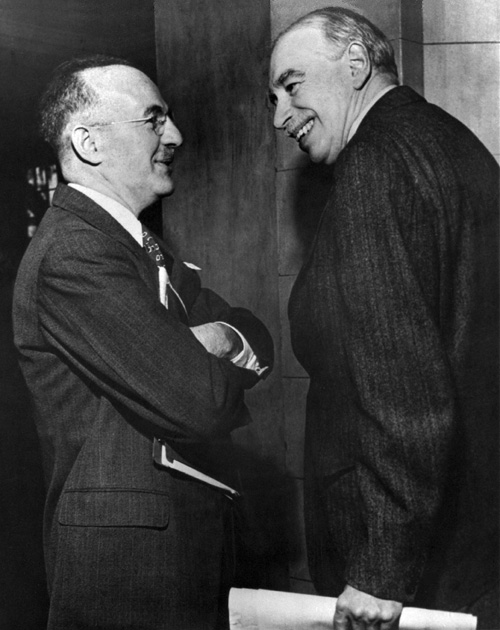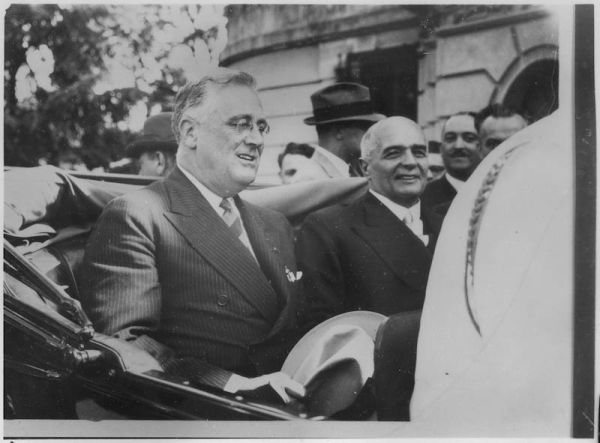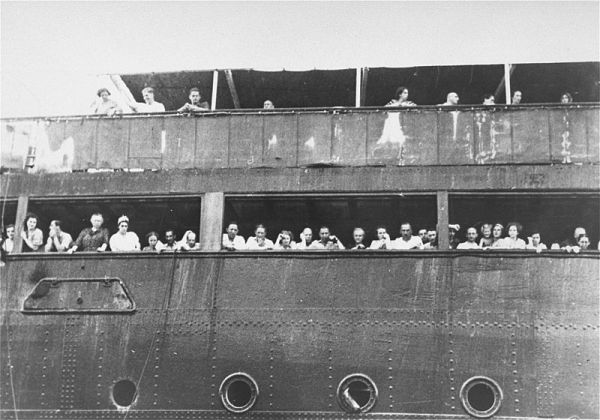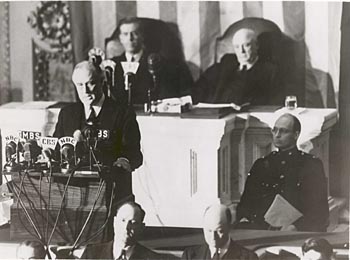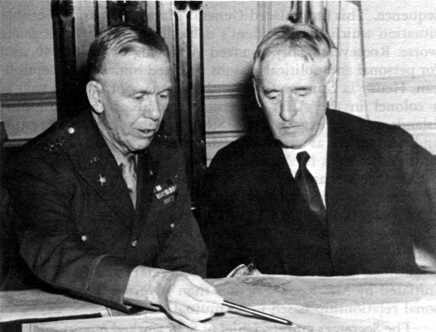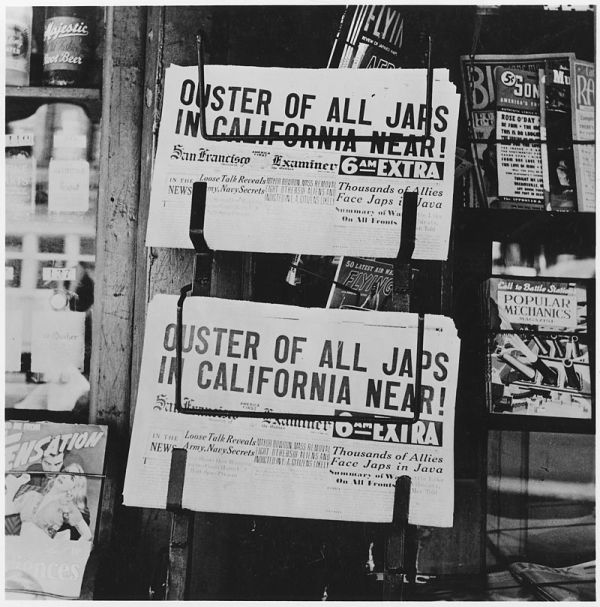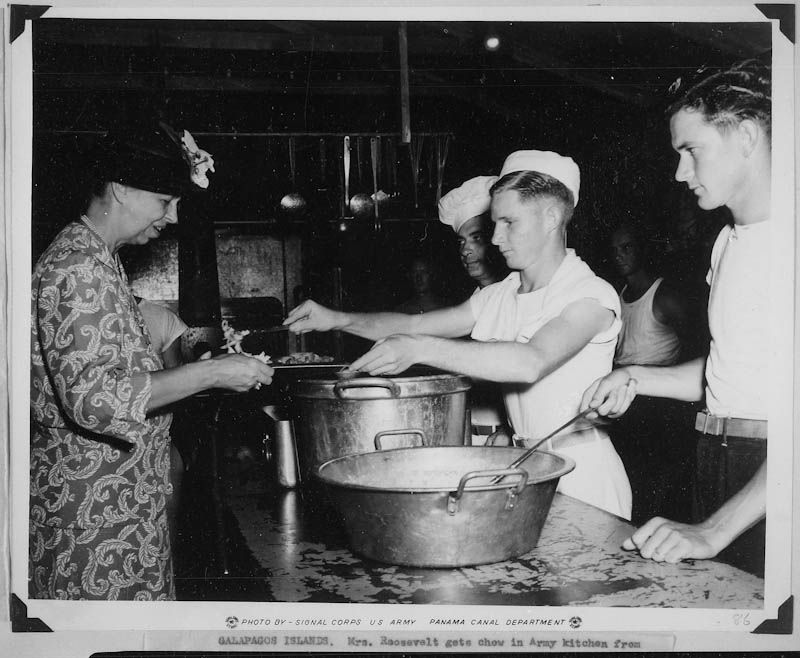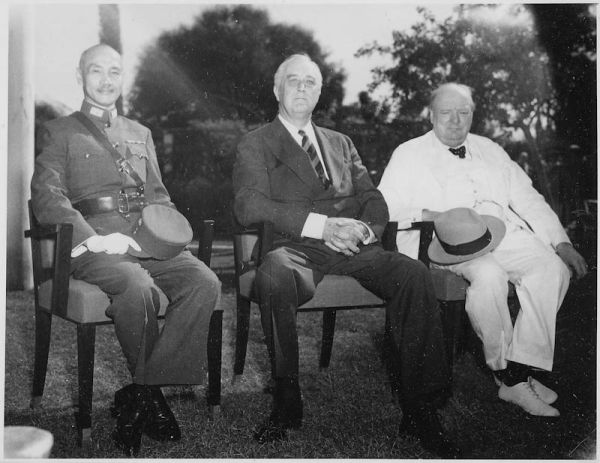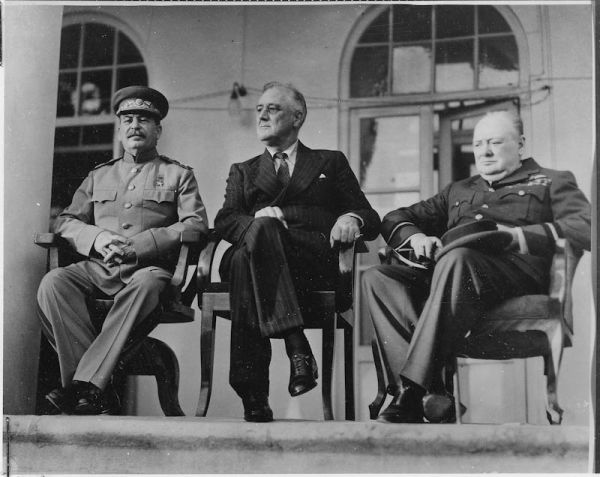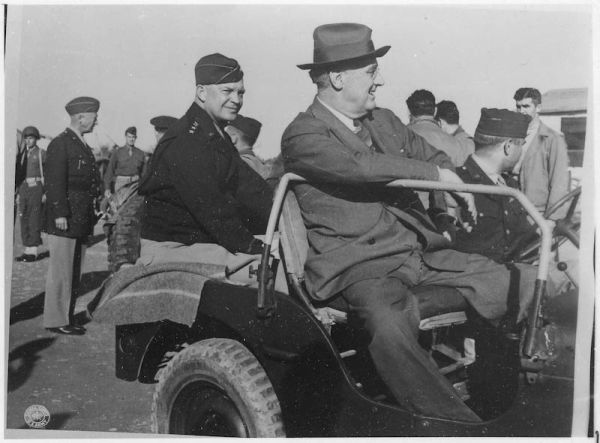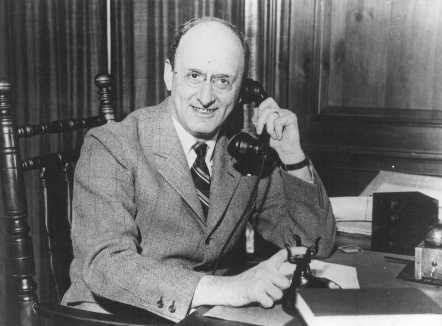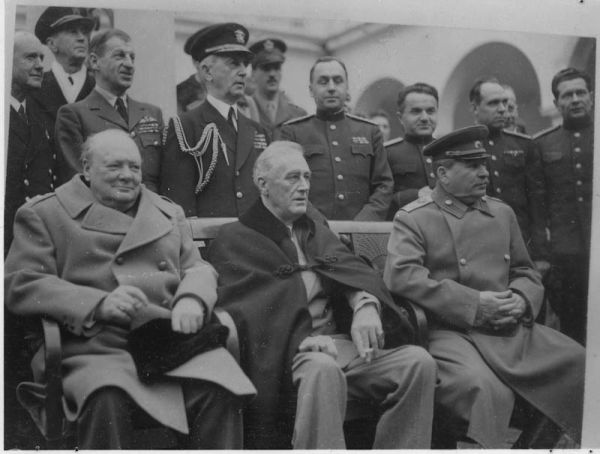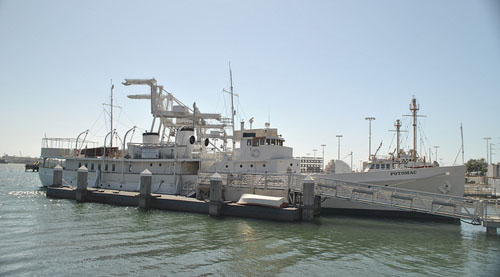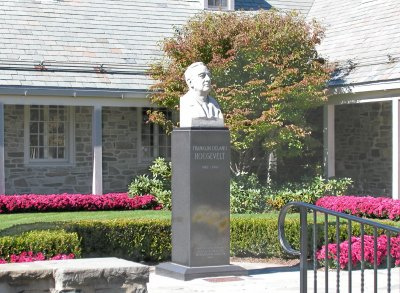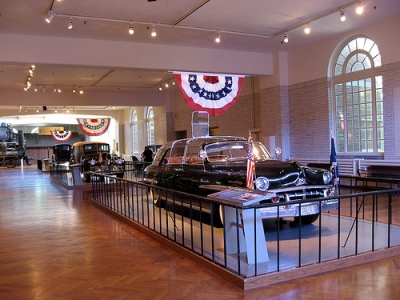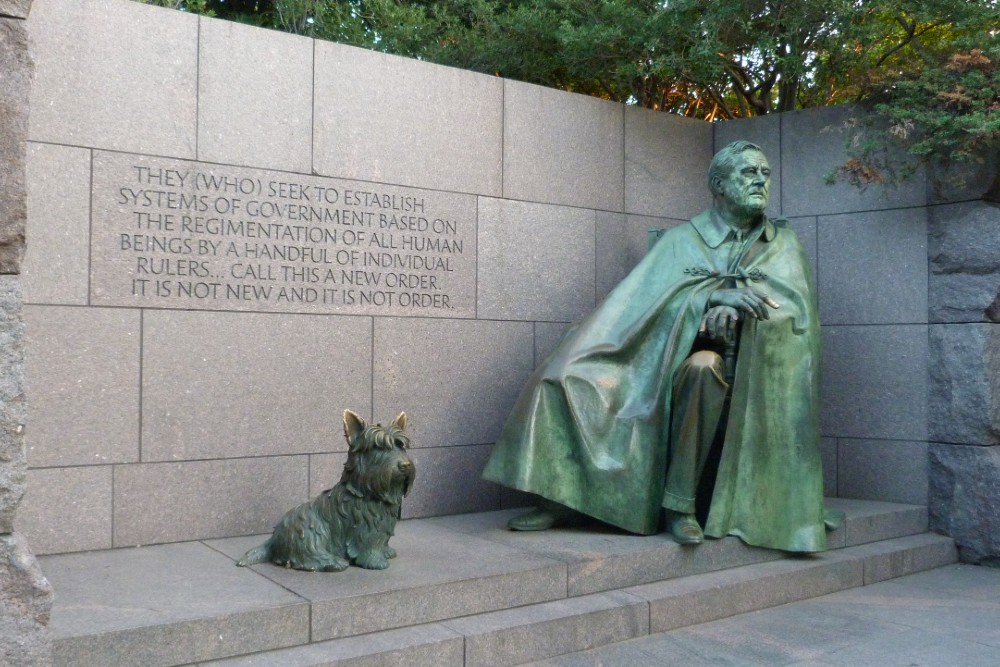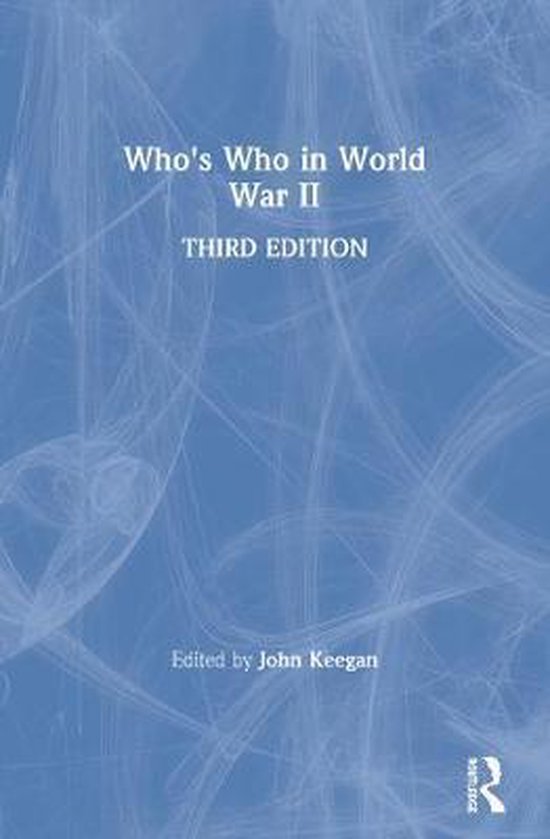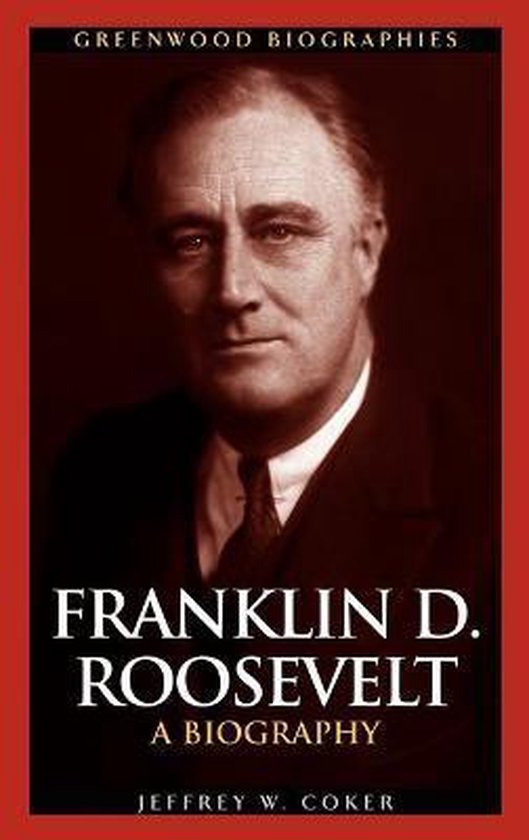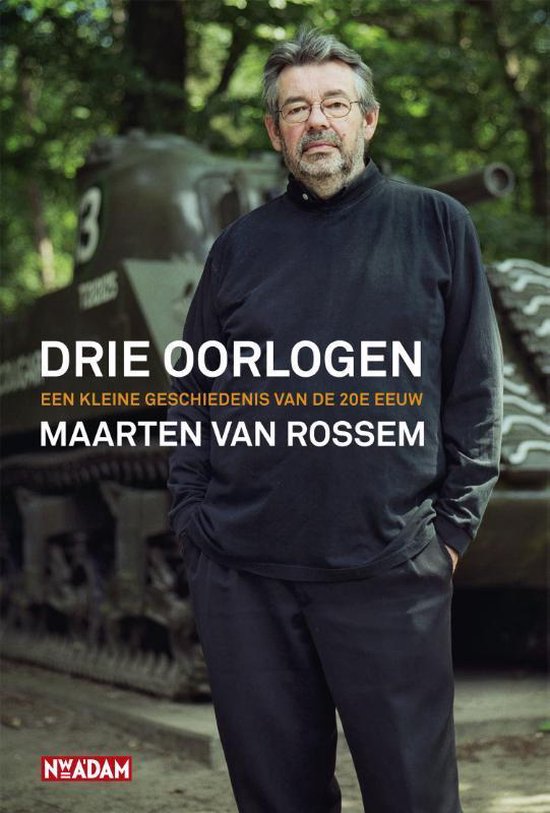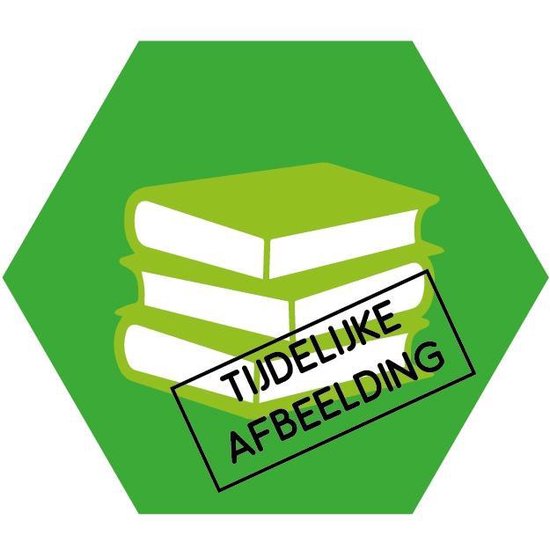Introduction
He was the 32nd and longest serving president of the United States in history, 12 years from 1933 to 1945. On taking office, the nation was in a deep economic recession. To millions of Americans, the future looked far from good during the Big Depression. Many lived below the minimum level of sustenance after having lost their jobs. Franklin Delano Roosevelt, in short FDR, brought them new hope. The charming and socially devoted president, who came from an elitarian environment himself, wanted to make life for the common American bearable again. in his opinion, revolutionary measures were required to achieve this. He wanted to be more than just a disassociate ruler. "The presidency is no clerical function," he declared shortly after taking office. "It is a place where moral leadership is executed from."
President Roosevelt also had to cope with a new world war. The United States had come to the assistance of the Western Allies during the First World War but when Roosevelt took office, an isolationist attitude prevailed in the country. Few Americans were ready to sacrifice their sons once again for peace in Europe. The President however, despite strong opposition in Congress, refused to stand by idly and watch befriended democracies be run over by Nazi Germany. He supported the Allied cause by delivering weapons to their armed forces. Following the Japanese attack on the U.S. naval base at Pearl Harbor on December 7th, 1941, America went to war herself. After having guided the United States through the Big Depression, from 1941 onwards, Roosevelt stood at the helm of a world power at war.
Definitielijst
- First World War
- Took place from 1914 till 1918 and is also named The Great War. The conflict started because of increased nationalism, militarism and neo-colonialism in Europe. Two alliances battled one another during the 4-year war, which after a dynamic start, resulted into static trench warfare. The belligerents were the Triple Alliance (consisting of Great-Britain, France, and Russia; later enlarged by Italy and the USA, amongst others) on the one hand and the Central Powers (consisting of Germany, Austria-Hungary, Bulgaria and the Ottoman empire) on the other hand. The war was characterized by the huge number of casualties and the use of many new weapons (flamethrowers, aircraft, poison gas, tanks). The war ended in 1918 when Germany and its allies surrendered unconditionally.
- moral
- The will of the troops/civilians to keep fighting.
- Nazi
- Abbreviation of a national socialist.
Images
Origin and childhood
Surrounded by woods and near the eastern bank of the river Hudson in the state of New York lies Springwood estate. The terrain, 1,15 sq. miles is situated in the small town of Hyde Park, some 80,78 miles north of the metropolis New York in the Hudson valley. Springwood was the central place in Franklin Roosevelt’s life. Apart from it being his birthplace, it was also the place where he lived the greater part of his life and the location of his final resting place. His father, James Roosevelt 1828 - 1900, bought the estate in 1866. He and his wife Sara Ann Delano (1854 - 1941), he moved into the 15-room mansion built in Italian style. During the presidency of his son, the building which was restyled and expanded numerous times, would be known as the Summer White House.
In Springwood, the Roosevelt family lived a life comparable to that of British aristocracy. James Roosevelt spent many hours in the horse stables and the running track on his estate. During his professional life, he was a businessman and chairman of the Delaware & Hudson Railroad that managed a rail network connecting New York to Montréal and Quebec in Canada. In addition he owned large tracts of land in Manhattan. Franklin Delano Roosevelt, born in Hyde Park on January 30th, 1882, was his only child of and his much younger wife Sara. He had a son James, born in 1854 from an earlier marriage whose children were about the same age as Franklin.
The history of the Roosevelt family in the U.S. goes back to Manhattan. In the 17th century, the Zealander Claes Maartenszoon van ‘t Rosenvelt settled in what was then the Dutch settlement of New Amsterdam. His son Nicolas dropped the addition Maartenszoon and took the name Rosenvelt which was later "Americanized" to Roosevelt. Via Nicolas’ two sons, Jacobus and Johannes, the family split into two branches named after the residence of the families: the Hyde Park branch (Jacobus) and the Oyster Bay branch (Johannes). Not only the Hyde Park branch but the Oyster Bay branch as well produced a president, Theodore Roosevelt, the 26th U.S. president who resided in the White House from 1901 to 1909. Both Theodore and Franklin belonged to the eighth generation Roosevelts in the U.S.
So it was in the prosperous surroundings of Hyde Park where the foundation was laid for the rise of Franklin Roosevelt, in the foot steps of his distant relative. Young Franklin enjoyed a very protected upbringing in the care of his loving but dominant mother. Sara Roosevelt was to play a big role in the life of her son up to her demise in 1941. His parental home in Springwood, where Sara would rule until her death, remained a life long and trustful haven for Franklin. Even during his presidency, his mother still supported him financially (the high post did not earn as much money as it does today). Here, he also received education at home by various governesses until he was 14 years of age. In his spare time, he devoted himself to spotting birds and collecting stamps. He would continue this last hobby during his adult life and presidency.
At the age of 14, Franklin left the protective environment of the family estate to attend the Episcopal School in Groton, Massachusetts for four years. After all the years of home education, the switch to the upper class boarding school was a big transition for young Roosevelt. Social contact with his fellow pupils was not easy for him and he was kind of an outsider at first. He was not a bad pupil but did not excel either. Nonetheless, his school record was sufficient to make the transfer to Harvard College in 1900, a branch of Harvard University for bachelor students in particular. There he did not portray himself as an intellectual ace either; nor was he a worthwhile sportsman: he was kicked out of the University football team because he was not considered athletic enough. Socially, Roosevelt did better. He was a member of various student bodies although, to his disappointment, he was not admitted to the most prestigious Porcellan Club his uncle Theodore had belonged to. Roosevelt also made contributions to the Harvard Crimson as a journalist and later on he became editor-in-chief of this university paper.
In 1903, Roosevelt graduated from Harvard University with a Bachelor degree in history. His father had not lived to see this memorable moment in his son’s life as he had died in 1900. In his pre graduation year, Roosevelt met his future wife, Anna Eleanor Roosevelt, two years his junior. The somewhat insecure and extrovert girl was a distant relative, a niece of Theodore Roosevelt who was president from 1901 onwards. She was well educated, well traveled and moreover of respectable descent, so a good marriage partner for the Harvard student. The couple married on March 17th, 1905. Because her parents had both passed away, none other than her uncle, the president, gave the bride away during the wedding ceremony. Theodore Roosevelt had a lasting influence on Franklin. Later he would call him "the greatest man I have known". Although his distant relative belonged to the Republican party and Franklin himself joined the Democratic party, the 26th president was a role model to him.
Images
Early career in politics
A lot of time would pass before Franklin took the same office as his wife’s uncle. In his younger years he had never aspired a political career. In fact he had wanted to join the navy. His protective parents thwarted this as they did not want their only son to be too far away from home or too long. His father wanted Franklin to find a job in business, just like himself. After Harvard he continued his studies at Columbia Law School in New York, although he did not graduate. In 2008, this University would still posthumously award a doctor’s degree in law to him and to Theodore Roosevelt who had not finished his studies there either. As Franklin had successfully passed his bar examination in the state of New York, he was authorized to practice law. He was hired by the prestigious law firm of Carter, Ledyhard & Millburn on Wall Street. It soon dawned on him that a career in law was not his passion.
Inspired by uncle Theodore, Roosevelt opted for a career in politics. In 1910 he was the Democratic candidate in the election for the New York Senate. After an active campaign, financed by his mother, he won a seat as representative for the counties Dutchess, Columbia and Putnam. In the senate, he successfully opposed the so called Tammany Hall, a powerful faction within the Democratic party machinery in the state of New York that was less reform minded than he was and in which corruption was no exception. In 1911 Roosevelt succeeded in blocking the appointment of the Tammany Hall candidate to the American Federal Senate. In this period he also made the acquaintance of the former political journalist Louis McHenry Howe, who was to play an indispensable role in his political career in the years to come. Sloppily dressed and unkempt, Howe looked nothing like the charming and vital dandy Roosevelt was but as his spin-doctor, he lifted the politician to great heights. From the beginning, Howe would have considered Roosevelt the future president of the U.S.
In 1912, Roosevelt was re-elected to the New York senate. The same year, he supported the campaign of Woodrow Wilson, the Democratic presidential candidate. Wilson won with 42% of the votes and appointed 31-years-old Roosevelt in March 1913 Undersecretary of the Navy in reward for his support, a function Theodore Roosevelt had also held prior to his presidency. Being in the center of power, Roosevelt made important political contacts in Washington. He and his wife were welcome guests in the higher circles in the capital. Roosevelt also was popular in the navy, From his childhood onwards, he displayed a love for sailing, shipping, the navy and showed interest in the well being of the sailors. He was a firm advocate of an efficient navy and often went against the orders of his chief, Secretary of the Navy Josephus Daniels who took a more pacifist course but accepted Roosevelt’s arbitrary conduct nonetheless. During the presidency of his former subordinate, Daniels would be appointed Ambassador to Mexico.
In the 1916 presidential elections, Roosevelt again supported the incumbent president who was re-elected by a tiny majority. In his first term in office, Wilson had managed to keep America out of the First World War, he nevertheless declared war on Germany on April 2nd, 1917. At the front in Europe, the American troops soon tipped the balance in favor of the Allies. In July 1918, Roosevelt paid a visit to the front in France. In the same period, he made a loose acquaintance with Winston Churchill, at the time Minister of Munitions, who would find an important ally in Roosevelt during the next world war. Roosevelt also spoke to the British King and the command of the navy about America’s participation in the war. On the home front, Eleanor made herself useful too. She became active for the Red Cross and visited army hospitals. During the flu epidemic of 1918 she tended to the sick in Washington as a volunteer.
The Roosevelt couple had six children. In 1906, their first and only daughter Anna was born, followed by their first son James the next year. Franklin jr. was born in 1909, but he passed away eight months later. 1910, 1914 and 1916 saw the birth of respectively Elliot, Franklin jr. and John. The marriage of the couple so rich in children was put to a severe test in 1918 when Eleanor found out about her husband’s secret affair with her private secretary Lucy Mercer Rutherford. It happened after Franklin had returned from Europe in September and was recuperating from a pulmonary infection he had contracted over there. Eleanor discovered love letters from Lucy in his suitcase. The duped spouse was deeply hurt and suggested a divorce. Franklin, but his mother as well, feared that might be the end of his political career and promised Eleanor he would never see Lucy again. The marriage held but intimacy would henceforth be out of the question. From then on, Eleanor and Franklin would go through life more like a political couple than as spouses. Franklin would break the promise to his wife as he secretly kept in touch with his mistress. Suggestions exist to the effect he had other extra-marital affair as well.
Shortly after the crisis in his marriage, Roosevelt again left for Europe, accompanied by his wife. Over there, Germany had signed the armistice on November 11th, 1918 effectively ending the Great War. While Roosevelt supervised the demobilization of the American navy, his wife encouraged injured American soldiers in army hospitals. Their trip past the former battlefields and their visit to London came to an end in February. The couple returned to the U.S. aboard SS George Washington, accompanied by President Wilson. Wilson and Roosevelt were strong advocates of the League of Nations, the supranational organization that was to prevent all future wars. To his disappointment, the President failed to reach the two thirds majority in the Senate, required for entering the League. During the following period, up to the attack on Pearl Harbor by Japan on December 7th, 1941, America adopted an isolationist policy; the country disassociated itself as much as possible from world politics.
Definitielijst
- First World War
- Took place from 1914 till 1918 and is also named The Great War. The conflict started because of increased nationalism, militarism and neo-colonialism in Europe. Two alliances battled one another during the 4-year war, which after a dynamic start, resulted into static trench warfare. The belligerents were the Triple Alliance (consisting of Great-Britain, France, and Russia; later enlarged by Italy and the USA, amongst others) on the one hand and the Central Powers (consisting of Germany, Austria-Hungary, Bulgaria and the Ottoman empire) on the other hand. The war was characterized by the huge number of casualties and the use of many new weapons (flamethrowers, aircraft, poison gas, tanks). The war ended in 1918 when Germany and its allies surrendered unconditionally.
- League of Nations
- International league of Nations for cooperation and security (1920 – 1941). The League was located in Geneva, in neutral Switzerland. During the 1930s the league of nations could do little against aggressive behaviour of Japan, Manchuria, Italy, Abyssinia and Hitler. The league of nations was in fact the predecessor of the United Nations.
Images
Exit from politics and paralysis
As early as 1914, Roosevelt had vainly tried to be elected Senator of New York in Washington. During the Democratic pre-election, a candidate was chosen in his place who was supported by Tammany Hall. During his tenure as Undersecretary in Washington, Roosevelt made the necessary contacts in the White House, improving his chances for higher functions. In 1920, he left the Department of the Navy and became running mate of the Democratic candidate James Cox in the 1920 presidential elections. Membership of the League of Nations was an important election issue for the Democrats. However, after the end of the war, the American population yearned for a return to normal circumstances and had no stomach whatsoever for American involvement abroad. That the socially devoted Eleanor, on spin-doctor Howe’s advice became involved in the campaign made no difference. The Democrats suffered a major defeat: the Republican presidential candidate Warren Harding won 61% of the votes.
After having missed an important position for the second time, Roosevelt felt obliged to step down from politics and he returned to the New York business world. He took the job of vice-president of the Wall Street branch of the Fidelity & Deposit Company of Maryland. In addition he found employment as a judicial advisor. To recover from the hectic world of Wall Street, Roosevelt and his family enjoyed a holiday on Campobello Island in the summer of 1921, a Canadian island off the coast of America’s most northeasterly state, Maine. On the island, rich in nature, that had been a popular holiday resort for wealthy Canadians and Americans since the end of the 19th century, the Roosevelts owned a summer residence where Franklin as a child had spent his holidays with his parents. During that period, he developed his love for sailing and swimming.
Roosevelt’s stay on Campobello island saw a dramatic end in that summer of 1921. After having returned from a sailing trip on August 10th, he did not feel well and decided to take a rest in bed. His condition deteriorated, he developed a high fever and suffered from great pains in his lower back and legs. After a few days, when he was unable to move his legs and was paralyzed from the waist down; the diagnosis of infantile paralysis or polio was made two weeks later. Today, it is assumed that the Guillaume-Barré syndrome (a somewhat rare muscular disorder that can occur spontaneously and can lead to paralysis) had been the real cause of the disability of then 39 years old Roosevelt. A period of seven years of revalidation lay ahead but Roosevelt would never be able to walk on his own anymore. Subsequently, he would remain scared of fire for the rest of his life as he feared not to be able to get away in time.
Roosevelt tried to improve his condition with hydrotherapy. From 1924 onwards, he was a regular visitor of the health resort Warm Spring in western Georgia, where the natural warm wells were said to have a soothing effect on polio patients. In 1926, he bought the run down resort, transforming it into a hydrotherapy center, now known as the Roosevelt Warm Springs Institute for Rehabilitation. He opened the center to other patients, including many children. In 1932 he had a cottage built on the premises which would become a familiar haven for him during his presidency; as a result it was also known as the Little White House and in which he would pass away in 1945. Mr. Roosevelt, as the inhabitants called him before he was elected to the presidency, was adored by them. The establishment of his institution meant a rejuvenation of their little town. They were satisfied with the personal attention being paid to them by Roosevelt and to the poverty and the poor education they had to cope with. He fully enjoyed the contact with the local people and the children in his health institute. In Warm Springs, he was long outside elitarian circles for the first time.
The hydrotherapy did not cure Roosevelt but it did make him feel better. With the aid of metal braces on his legs, he learned to stand upright and he was also able to walk a few steps, usually supported by one of his sons or an associate or using a walking stick. Despite his handicap, driving remained a favorite pastime of Roosevelt, even during his presidency when the speed devil often gave the Secret Service a hard time keeping up with him on his rides on secondary roads. The cars he drove had been specially adapted for him. He also used a wheel chair but he did not appear in it in public. He did not wish to be considered a cripple and he would hardly ever speak about his disability, even during his presidency. His relationship with the national press was so good that journalists respected his silence about his disorder. American journalist never reported about his disability and on pictures or movies, his handicap was not shown to the American public either. As far as is known, there are only two pictures of him in a wheel chair. As a result, few Americans knew about the handicap of their president.
Definitielijst
- League of Nations
- International league of Nations for cooperation and security (1920 – 1941). The League was located in Geneva, in neutral Switzerland. During the 1930s the league of nations could do little against aggressive behaviour of Japan, Manchuria, Italy, Abyssinia and Hitler. The league of nations was in fact the predecessor of the United Nations.
Images
Return to the political stage
While her husband was working hard at his recovery, Eleanor deputized for him. Louis Howe had advised her to show her face as much as possible, within the Democratic Women’s movement for instance in order to prevent the name Roosevelt from fading into oblivion. With Howe’s help, the once so shy woman developed into an appreciated personality in the Democratic party. Franklin himself even returned to the New York business world during his recuperation and founded a new legal agency in 1924 with his business partner Basil O’Connor.
The same year he appeared in public for the first time since he had fallen ill. During the Democratic convention in Madison Square Gardens in New York, he delivered a speech, leaning on the desk in order not to fall. The speech, in which he supported the candidacy of New York governor Alfred E. Smith, was warmly received and became known as the Happy Warrior Speech as Roosevelt called the presidential candidate the happy warrior of the political battlefield, referring to a poem by British William Wordsworth of 1806. Despite Roosevelt’s support, Smith lost the presidential nomination in 1924 to the unknown Senator John W. Davis who in his turn was overwhelmingly defeated by the Republican Calvin Coolidge. Meanwhile, Roosevelt had toned down his criticism of Tammany Hall as Smith had close ties with this group.
Renewed support by Roosevelt four years later did not help Smith into the White House either. Although Smith did win the Democratic nomination this time; on November 6th, 1928, Republican Herbert Hoover won the elections by a majority never seen before. He received over 21 million votes and 444 electoral votes versus over 15 million votes and 87 electoral for Smith. Roosevelt had more success himself in the election for governor of the state of New York. After having been recommended as a candidate for governor by the Democratic party in New York and by Smith, he defeated his Republican opponent Albert Ottinger by a minimal majority of 0,6%. On New Year’s Day 1929, the Roosevelts moved into the governor’s residence in the state’s capital Albany, some 124,2 miles north of New York. During two terms of two years, Roosevelt would hold the office of governor; although during the elections for his second term supported by a decisive majority.
For Roosevelt, the governorship was an important training ground for the presidency. In his first term, the American Exchange crashed on October 24th, 1929, a day that has become known as Black Thursday. Years of speculation on the Stock Exchange with money loaned and stimulated by the economic revival of the 20s, had rocketed the prices of shares sky high. The real economic situation in the U.S. was out of all proportion to the steadily rising prices of shares. Surplus in production and in agriculture, increasing unemployment and a decrease in civil construction were writings on the wall that the Roaring Twenties had come to an end. The American Wall Street Crash ultimately triggered a global economic crisis that lives on in history as the Great Depression.
The crisis led to diminishing industrial production and further rise of unemployment. In order to alleviate the consequences of the economic malaise for the population of the state of New York, Roosevelt pursued an active social policy. He introduced a tax reduction for farmers and made electricity cheaper for the consumer. In his second term he founded the Temporary Emergency Relief Administration (T.E.R.A.), headed by his advisor Harry Hopkins who was to act as Roosevelt’s most important advisor during his presidency. TERA provided support to 10% of the families in the state. Roosevelt put the unemployed to work again on civil construction projects. He also issued laws on pension and unemployment insurances. All these social measures heralded the later so called New Deal: the social democratic recovery program Roosevelt would launch during his presidency. Among all those crisis measures, there were still ceremonial obligations: on February 4th, 1932, Governor Roosevelt declared open the third Olympic Winter Games in Lake Placid.
Images
The road to the White House
After Roosevelt’s second term as governor of New York the economic situation in the United States had deteriorated even more. 1930 saw 4 million unemployed, a year later that number had doubled. In the next year, in the winter of 1932 - 1933, the number of unemployed doubled again. As the Americans attempted to draw their savings from the shaky banks in masses, many of them closed their doors due to problems of liquidity. Everything seemed to point to the United States balancing on the rim of a financial collapse. Recovering the economy therefore played an important role during the 1932 presidential elections. The Democratic party with Roosevelt as its presidential candidate engaged the incumbent Republican president Herbert Hoover who was considered by many Americans to be responsible for the crisis. The slums that had popped up all over America, which housed hundreds of thousands of victims of the crisis in deplorable conditions, were widely known as Hoovervilles. The political battle between the fresh newcomer Roosevelt and the unpopular president was far from exiting.
Directed by spin-doctor Louis Howe, Roosevelt conducted an energetic campaign. John Nance Garner, Speaker of the Federal House of Representatives was his running mate. Roosevelt crisscrossed the country by train and by plane in order to reach as many voters as possible. In particular, he focused on the common man who had been affected most by the crisis. His election posters read: "He’s ready! Are You?" He presented himself as the people’s man with his slogan Return the government to the people in which he succeeded very well despite his elitarian origin. He managed to win over many voters by his natural charm, his sense of humor and his determined attitude. He was particularly popular among minorities like Afro-Americans who had been hit hard by the crisis. There was however no question of a fixed political program. During the Democratic convention in Chicago, where Roosevelt had beaten his old rival Alfred Smith in the race to the nomination, he did promise a "new deal for the American people" but only during his presidency, the New Deal (in initial capitals) would be developed. Conspicuously though, Roosevelt took a conservative stand during the campaign: he urged for cuts in expenditures to bring down the national debt.
On November 8th, 1932, Roosevelt won the presidential election by a huge victory over Hoover. He received 22,8 million votes against 15,7 million for his Republican opponent. With 472 electoral votes against 59, the door to the White House stood wide open. He was supported in the Senate as well as in the House of Representatives by a large majority. In the four months between his election and his inauguration, Roosevelt refused to co-operate with the frustrated Hoover as he was not willing to support Republican policy. During the same, so called lame duck period, the president-to-be survived an assassination attempt during a visit to Miami, Florida on February 15th, 1933. After he had delivered a speech, the Italian-American anarchist Giuseppe Zangara fired a shot in his direction. Roosevelt remained unhurt, five others sustained injuries. One of them, the Democratic Mayor of Chicago, Anton Cermak later succumbed to his wounds. Cermak had probably been the real target for the stern approach against criminality he advocated in his city.
The big day finally arrived on March 4th, 1933. The grounds on the east side of the Capitol in Washington DC, where the inauguration of the new president was to take place, was crowded with people. Ten million Americans were waiting at their radios for the transmission of the ceremony. Assisted by his son, Roosevelt cautiously came down the stairs to the spot where he would take the oath of office. His hand on a Bible, printed in Amsterdam in 1686, a revered family treasure that had belonged to his forebear Jacobus Roosevelt, he swore the oath on the Constitution. The words he used in his inaugural address have become legendary: "The only thing we have to fear is fear itself," he told the American people in encouragement. President Roosevelt entered office, apparently fearless and determined to lead America out of the crisis.
Images
The first New Deal, his first 100 days
The new occupant of the White House had no time to calmly ponder over an approach to the crisis. Immediate action was paramount because a complete collapse of the monetary system was looming as more and more banks were closing down. At the time of Roosevelt entering office, banks had closed in 38 states. In his inaugural address he had already announced that all banks had to close down for an indefinite period in order to enable the Department of Finance to set things straight. This Bank Holiday was effective from March 6th, 1933 and officially lasted four days. The Emergency Banking Act, speedily passed during a special session of Congress on March 9th, made postponement of re-opening of banks possible and granted the President more authority over the banking world in times of crisis. Later that year, in June 1933, the Federal Deposit Insurance Corporation (FDIC) was founded, a federal watchdog aimed at preventing a future banking crisis by supervision.
In order to assure the Americans once more that their money was safe in the bank, he addressed the nation on March 12th from the White House during his first "cozy chat at the fireplace," which was to be followed up by 29 more during his presidency and were listened to by an estimated 60% of the population. "I can assure you, your money is safer in a bank that has re-opened than under your mattress" he said to put the people at ease. Partly because of his words and by the government’s warrant for $ 2,500 on savings, confidence was restored and the run on banks was stopped. A financial catastrophe may have been averted but to restore the economy and lower the massive unemployment, much more was required. There was no question of a fixed recovery program: in the years to come, several experimental measures would be introduced, each a part of Roosevelt’s all encompassing New Deal.
A hodge podge of characters, that’s how the media called the new agencies and laws that made up the New Deal because of the abbreviations they were known by. In the first 100 days of his presidency, Roosevelt managed to achieve much in this connection. The Federal Emergency Relief Administration (FERA) founded in May, was the continuation of the unemployment program of his predecessor Hoover’s Emergency Relief Administration (ERA) that was based on the Temporary Emergency Relief Administration (TERA), Roosevelt had established in New York as a relief organization for the unemployed. FERA had the same goal and top advisor Harry Hopkins, who had also headed TERA was appointed chief of the organization. Setting up soup kitchens for the unemployed and distributing bread among the families that had been affected by the crisis were the main tasks of the organization. One branch of FERA, founded in November, was the Civil Works Administration that provided the unemployed with temporary labor in restoration and construction of bridges, roads, airfields, schools, sporting grounds and so on.
Another ingredient of the letter soup and Roosevelt’s favorite agency was the Civil Conservation Corps (CCC), set up in March and which deployed - until 1942 - unschooled and unemployed young men between 18 and 25 at $ 1 a day in developing and maintaining National Parks and reservations. Another project for the provision of labor was launched by the Tennessee Valley Authority or TVA (set up in May 1933). The goal was to construct 29 river dams to generate cheap electricity to enable the Tennessee Valley, which had lagged far behind economically and encompassed seven states, to be industrialized. During World War Two, the electric power generated by these dams would be of great value in the production of aluminum, an indispensible material for the aviation industry.
Apart from programs to provide labor, in the first 100 days of Roosevelt’s first term in office, measures were also taken to support agriculture and the economy. In May, the Agricultural Adjustment Act (AAA) was passed by Congress, it was meant to put a stop to the overproduction of agriculture which lowered the prices farmers received for them. Farmers were granted an allowance for maintaining waste areas and production quota were imposed on them. A controversial part of the AAA was the destruction of crops and livestock in order to lower overproduction while in contrast many Americans were starving at the time. In order to regulate and reform the economy by the government, the National Industrial Recovery Act (NIRA) was passed in June, leading to the establishment of the National Recovery Administration (NRA) and the Public Works Administration (PWA).
The National Recovery Administration, characterized by a blue eagle, was the most conspicuous part of Roosevelt’s New Deal in American society. The logo appeared on posters hanging in shop windows and on the packaging of products. It also appeared in trailers prior to movies for instance and even during street parades, held to promote NRA. The blue eagle indicated that the shop owner, manufacturer or movie producer complied to the rules laid down in the Nation Industrial Recovery Act. The worker’s right on collective negotiations through trade unions, minimum wages and maximum working hours and child’s labor being permitted no longer were elements of this law. Companies were bound to rules concerning fair competition and guaranteed prices. All these measures were aimed at increasing buying power and employment. "The aim of all these measures," as Roosevelt himself explained, "is to provide industry with good profits and to grant laborers a fair compensation for their work."
The Public Works Administration (PWA, initially known as the Federal Emergency Administration of Public Works), was established in order to support the construction sector and was headed by the Secretary of the Interior, Harold L. Ickes. Construction of large public projects such as dams, bridges, hospitals and schools, was granted to necessitous contractors. Between 1933 and 1943, the government spent a total of 6 billion dollars on this kind of contractors who could, thanks to this government support, employ workers and so contribute to the decrease of unemployment. The Triborough Bridge and the Lincoln Tunnel, both in New York City and the Grand Coulee Dam in the state of Washington are just a few examples of these prestigious PWA projects. Trains of the Pennsylvania Railroad from New York to Washington DC were powered henceforth by electricity, thanks to the PWA.
Images
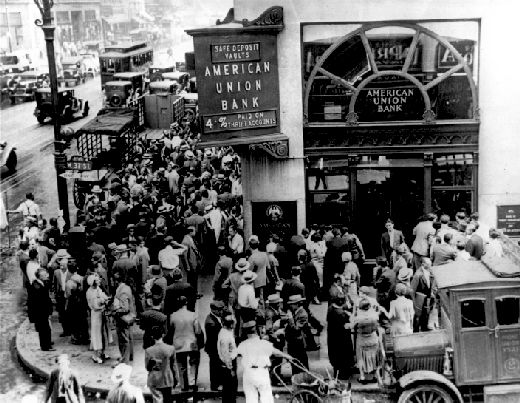 Americans gather at a bank in New York to take out their savings. Roosvelt’s "Bank Holiday" was meant to prevent such a run on banks. Source: Public domain.
Americans gather at a bank in New York to take out their savings. Roosvelt’s "Bank Holiday" was meant to prevent such a run on banks. Source: Public domain.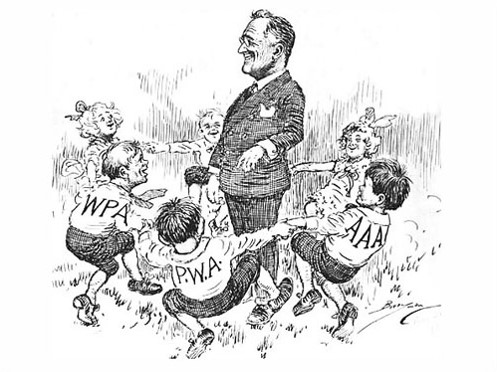 Cartoon of Roosevelt with children dancing around him with the abbreviations of parts of his New Deal on their backs. Source: Public domain.
Cartoon of Roosevelt with children dancing around him with the abbreviations of parts of his New Deal on their backs. Source: Public domain.The second New Deal
"Happy days are here again", this catchy song added luster to Roosevelt’s 1932 presidential campaign. In it, a promise was hidden that seemed to be fulfilled around 1934. Thanks to the New Deal, millions of unemployed had returned to work and the soup kitchens and other emergency measures made the crisis more bearable for many. The President, who encouraged the American people and put them at ease in a fatherly tone during his "cozy chats at the fireplace, " managed to win the confidence of many. He gave American hope and chances again. All this positive news however, could not hide the fact that the United States still faced serious problems. Under Roosevelt’s presidency, unemployment had decreased in two years from 15 to 11 million but it still was a large number. Although the deflation had been stopped, there still was no question of a structural reform around 1934. The New Deal also met with increasing criticism. Entrepreneurs berated the government’s intervention by the National Recovery Administration. The raising of taxes Roosevelt had introduced in order to finance all these reforms could not count on wide support by the American wealthy elite either, who were of the opinion that Roosevelt - in the past one of their own - had betrayed them.
Despite the criticism, a large part of the American population still backed their president as became evident after the by-election for Congress of November 1934. Both in the House of Representatives and in the Senate, the Democratic majority increased. This did not mean however that Roosevelt could freely execute his policy without any opposition. That became obvious for the first time in 1935 when the Supreme Court judged the NIRA and the AAA, the two most important pillars under the New Deal, to be in violation of the Constitution. The court, consisting of nine judges, most of them having been appointed by Republican presidents, argued that the government’s intervention in industry was undermining the liberal economy. The great power Roosevelt wielded as president was, in the opinion of the Court, in violation of the division of power, laid down in the Constitution. Roosevelt was angry about the judges’ verdict. He named them Nine Old men, referring to their age, who turned a blind eye to the crisis situation which had, in his view necessitated drastic measures. He was not disappointed however as he would issue various new measures in that same year which in their entirety would also be called the Second New Deal.
In 1935, the FERA was replaced by the Works Progress Administration (WPA), renamed the Work Projects Administration (WPA) from 1939 onwards (not to be mistaken for the Public Works Administration, founded in 1933) and the Social Security Administration (SSA). Just as the Civil Works Administration had done in 1933 and 1934, the WPA (established in 1935), the largest and most ambitious of the New Deal organizations, put the unemployed to work in public renovation and construction work. When the organization was disbanded in 1943, after the unemployed were put to work in the war industry, some 8 million unemployed would have been put to work led by Harry Hopkins. Apart from the poorly educated, the WPA helped artisans, musicians, actors and writers to get work through the Federal Project Number One. In this way, artisans were deployed in creating art for public buildings and in recording daily life in America.
The Social Security Act (SSA), effective as from August 1935, which lay at the base of the Social Security Administration was the most far-reaching element of Roosevelt’s New Deal and up until today, Americans still benefit by it. Previously, there hardly was - or not at all - a social net for unemployment, old age and illness and the SSA laid the foundation for the caring state which would however never evolve into the wide ranging system of Western Europe. There were not only benefits for unemployed, ill or elderly Americans but it also promoted employment. As elder employees could retire more easily, room was made on the labor market for the young and the unemployed. Even today, social security in America is still directed by the SSA.
Other elements of Roosevelt’s Second New Deal were the Rural Electrification Act, the Revenue Act, the National Labor Relations Act and the Banking Act. Thanks to the Rural Electrification act, more agricultural enterprises would be hooked up to the electricity network. Prior to the introduction of the law and the passing of the Rural Electrification Act, nine out of ten of agricultural enterprises had no electricity at their disposal; in 1941, that number had shrunk to four out of ten. The Revenue Act of 1935 enabled a tax increase over high incomes and in the National Labor Relations Act, also called the Wagner act after its initiator New York Senator Robert F. Wagner, the right to strike and the rights of the unions during negotiations on conflicts with employers were laid down. The Banking Act of 1935 raised the governmental guarantee on savings to $ 5,000.- and made the FDIC a permanent organization which still exists today.
Images
His first re-election and return to a recess
Relief, recovery and reform, that was where Roosevelt’s New Deal policy was aimed at. Around 1935, there was indeed a question of relief and reform: as a result of various far-reaching reforms in the field of social security, the population felt a lessening of the crisis. In the Fair Labor Standards Act (FLSA), issued during his second term in office, the position of employees was further enhanced by legal minimum wages and a working week of 44 hours at most. Recovery of the economy however was still limited. The increase of industrial production, compared to May 1933, was still limited to 22% and unemployment still stood at 20,1% compared to 24,9% in 1933. The lack of economic reform was partially caused by higher taxes lowering the buying power.
The majority of the American population still backed its president, as was shown during the 1936 presidential elections, in which the president had to make do without his spin-doctor, Louis Howe who had passed away April 18th , 1936. vice-President John Nance Garner was his running mate again. Roosevelt’s victory over his Republican opponent, Kansas Governor Alf Landon, was even greater than that over Hoover in 1932. With 27,7 million votes (61%) against 16,6 million, he achieved the greatest victory in American history up till then. He was backed by 523 electoral votes against a meager eight for Landon. For the first time, the majority of the black population had voted Democratic despite the President never pronouncing himself against racial segregation, afraid as he was to alienate conservative Democrats from the southern states. The heritage of the Republican president Abraham Lincoln, who had abolished slavery, lost against Roosevelt’s New Deal, which benefitted Afro-Americans who had been severely affected by the Depression.
With an even larger Democratic majority in Congress, nothing seemed to stand in the way of Roosevelt continuing his policy. Self-assured as he was by the massive support of the American population, he first wanted to settle an account with the Supreme Court that had gone against him in 1935 by declaring part of his New Deal unconstitutional. With the Judiciary Reorganization Bill of 1937, he attempted to increase the number of judges so with judges appointed by him he could achieve a majority assuring him of sufficient support for his policy. It evoked a lot of criticism, not only from Republicans but also from members of his own party (headed by vice-President Garner no less), in particular from the conservative southern states. He was blamed that his proposed law, which ultimately was not passed, would be in violation of the division of power laid down in the Constitution. As in the course of years judges passed away and others retired, the President eventually managed to move the Supreme Court over to his side. During his 12 years in office, he was able to appoint eight judges including Robert Jackson, the future chief prosecutor during the Nuremberg International Military Tribunal.
Apart from the hassle over the introduction of the Judiciary Reorganization Bill, Roosevelt also had to cope with a new economic crisis during his second term. In the second half of 1937, 1,8 million Americans became unemployed and industrial production decreased by 30% within four months. American economy was in recession once again for about a year. It was caused by the conservative financial policy Roosevelt had pursued: as he had raised taxes and had cut government expenditure, buying power had decreased. The economic situation was restored when Roosevelt adopted the ideas of British economist John Maynard Keynes, including the notion that in time of recession, it was better to let the government spend money in favor of employment and buying power, even if the national debt increased as a result. The so-called Roosevelt recession and Roosevelt’s attempts to have opposing conservative Democrats silenced, caused the Republicans to win for the first time since 1928 in the November 1938 by-elections for Congress. The Democrats did however maintain their majority in Congress but nonetheless, the result of the election was a painful loss for Roosevelt.
Images
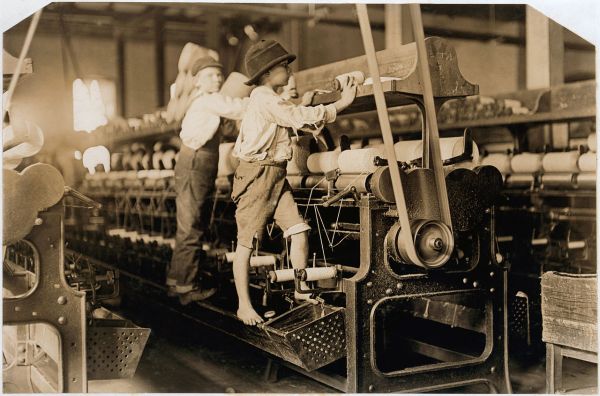 Roosevelts Fair Labor Standards Act enhanced the position of laborers. Child labor, as in this picture of 1909 of a factory in Macon, Georgia, was prohibited. Source: Library of Congress.
Roosevelts Fair Labor Standards Act enhanced the position of laborers. Child labor, as in this picture of 1909 of a factory in Macon, Georgia, was prohibited. Source: Library of Congress.War from the sidelines
Neither the New Deal, nor Keynesianism could put an end to the economic crisis. Ultimately, international developments and the increased American war production that went with it, killed the Great Depression. During the first years of his presidency, Roosevelt had hardly bothered with foreign affairs. Concerning Latin-America, Roosevelt pursued a policy of good neighborhood. During the seventh Pan-American Conference in Montevideo, from December 9th to 26th, 1933, the United States had committed herself by signing the Montevideo Convention on the Rights and Duties of States to abstain from armed intervention in Latin-America in the future, taking distance from the prevailing notion up till then that armed intervention in Latin-America in order to protect American interests was legitimate.
During the 30s, an isolationist mood was still prevailing in the United States. The Americans did not wish to be dragged into foreign conflicts once more as had been the case during the First World War. In August 1935, Roosevelt had signed the Neutrality Act which prohibited the export of arms to belligerent nations, resulting in the sale of arms to Italy and Ethiopia which were at war with each other, being canceled in October of that year. The sanctions against Italy were lifted in June 1936. In February 1936 as well as in May 1937, the Neutrality Act was extended and expanded. Roosevelt signed the subsequent bills unwillingly by the way but he felt obliged to do so as he needed Congressional support for his internal policy. Roosevelt was not blind however to the threat of war in Europe and the Japanese aggressive expansion; the Empire had invaded China from Manchuria in 1937; and in January 1938 he asked Congress for the first time for a raise of the armament budget in the interest of the American defense. In subsequent years, the defense budget of the United States would increase to no less than 41% of the gross national product in 1945. In this way, the armaments industry put an end to the recession and unemployment during the war years.
Prior to the outbreak of World War Two, Roosevelt had urged the German dictator Adolf Hitler (Bio Hitler) more than once to prevent war but his letters were received with derision in Germany. In 1938 he had withdrawn his Ambassador in Germany in protest against the Kristallnacht, the eruption of violence against Jews in the night of November 9th and 10th. When on September 1st, 1939, German tanks rumbled into Poland and England and France declared war on Germany two days later, America remained neutral however. Just as Roosevelt had failed to maintain peace in Europe, there was nothing he could do for Jewish refugees who wanted to leave Europe due to Nazi anti-Semitism.
During the Evian Conference in France in July 1938, called By Roosevelt, it appeared that only the Dominican Republic was willing to take in refugees from Germany and Austria, be it at high cost. That Roosevelt’s own country did not warmly receive Jews either became evident for instance in 1939 when the vessel St. Louis with over 900 Jewish refugees aboard, was refused entry into the United States and consequently had to return to Europe. Roosevelt did nothing to help the Jews aboard the vessel, despite their pleas for help. With by-elections for Congress imminent, he did not see any good in going against the wish of the majority of a population that felt nothing for a less stringent policy of admission.
Definitielijst
- First World War
- Took place from 1914 till 1918 and is also named The Great War. The conflict started because of increased nationalism, militarism and neo-colonialism in Europe. Two alliances battled one another during the 4-year war, which after a dynamic start, resulted into static trench warfare. The belligerents were the Triple Alliance (consisting of Great-Britain, France, and Russia; later enlarged by Italy and the USA, amongst others) on the one hand and the Central Powers (consisting of Germany, Austria-Hungary, Bulgaria and the Ottoman empire) on the other hand. The war was characterized by the huge number of casualties and the use of many new weapons (flamethrowers, aircraft, poison gas, tanks). The war ended in 1918 when Germany and its allies surrendered unconditionally.
- Jews
- Middle Eastern people with own religion that lived in Palestine. They distinguished themselves by their strong monotheism and the strict observance of the Law and tradition. During World War 2 the Jewish people were ruthlessly persecuted and annihilated by the German Nazis. . An estimated 6,000,000 Jews were exterminated.
- Nazi
- Abbreviation of a national socialist.
- Neutrality
- Impartiality, absence of decided views, the state of not supporting or helping either side in a conflict.
Images
The arsenal of democracy
Roosevelt’s repeated declaration that the United States would remain neutral after the outbreak of World War Two did not mean though his government kept entirely outside the conflict. The President’s sympathy was on the side of the countries that were threatened by or fighting against Germany and Italy. After the outbreak of war in September 1939, he managed to have the embargo of weapons deleted from the Neutrality Act. Based on the Cash and Carry principle - goods being sold against payment in cash to belligerent nations, provided they saw to their own transportation - war material was delivered to the British. In a final attempt to end the violence of war, Roosevelt dispatched his Undersecretary of Foreign Affairs, Summer Welles as his envoy to Europe in the winter of 1939-1940. He returned empty handed however. After the German invasion of western Europe, Roosevelt managed to get Congress behind him in order to raise the defense budget considerably to enable him to enlarge the army. In order to gain Republican support, he named two prominent Republicans as secretaries in his cabinet: Frank Knox as Secretary of the Department of the Navy and Henry Stimson as Secretary of the War Department.
"Save our sons," that was the slogan the America First Committee used - an organization in which isolationists of all walks of life had united - to protest against the United States becoming deeper involved in the war in Europe. As isolationists within the Republican party were also very influential, Roosevelt had to tread softly with his help to the British. There could be no question of open and disinterested support. When Winston Churchill, British Prime Minister since May 1940, urged Roosevelt to deliver destroyers that were necessary to protect the convoy routes, he asked for a counter action by the British to please the isolationists. In exchange for 50 destroyers of World War One vintage, the British promised him he could use British naval bases for the next 99 years such as on New Foundland and in the Bahamas (the so-called Destroyers for Bases Agreement). Another reason for Roosevelt’s cautious action was the 1940 presidential election. Although it had been an unwritten tradition since George Washington that presidents should hand over the crown after two terms in office, Roosevelt decided to go for a third term which was still permitted under the Constitution at the time.
"Your boys will not be sent to war in a foreign country," so Roosevelt assured concerned fathers and mothers prior to the election on November 5th, 1940. Although he won less votes than in 1936, he won the election by 27,2 million votes against 22,3 million for the Republican Wendell Wilkie, a businessman and former Democrat who had even supported Roosevelt in the 1932 election. With 449 electoral votes for Roosevelt and 82 for Wilkie and still enjoying a majority in Congress, Roosevelt could embark on his third term. Henry A. Wallace, since 1933 Secretary of Agriculture became vice-President; succeeding the conservative John Nance Garner, Wallace’s appointment was considered a political shift to the left.
Sure of his position for the next four years, Roosevelt dared to side more openly with the British and their allies. In a radio address on December 29th, 1940, he indicated that if Britain should be defeated, America would not be safe either due to the ever growing distances bombers could fly. He warned the Americans the nation should prepare itself for danger. "We cannot avert danger by going to bed and drawing the sheets over our heads," he said. It was not his aim to actively participate in the war but by delivering weaponry to the Allies, the United States should act as the arsenal of democracy.
Roosevelt’s foreign policy was aimed not only at American material support to the Allied war effort but he also had an eye for the long term. After the First World War, he had been a great advocate of the League of Nations. The U.S. however had never joined and with the outbreak of a new world war the organization had failed to reach its ambitious goal of ending all wars. Roosevelt however remained an advocate of an international organization that could solve disputes between nations in a peaceful way and he presented himself as a staunch advocate of international human law. In his State of the Union of January 6th, 1941, Roosevelt presented the four pillars everybody in the world had a right to, in his opinion. These so-called Four Freedoms were: freedom of speech, of religion, of want and of fear. These fundamental human rights would be incorporated after his death in the United Nations’ Universal Declaration of Human Rights of 1948.
While Nazi Germany dominated a large part of Europe, Roosevelt’s four freedoms seemed further away than ever. It was up to Great Britain, supported by other Commonwealth nations to defeat Nazi-Germany. As the British need for war material remained massive and at the end of 1940 the country could no longer afford the expense, Roosevelt made a proposal to Congress to lend American produced weaponry to Great Britain. Despite opposition from isolationists within the Republican party, the Lend-Lease Act was passed and signed by the President on March 11th, 1941. From then on, he had the power to decide to which countries he wished to deliver war material to when he considered it to be in the interest of the United States. Up to the end of the war, supplies valued at $50,1 billion would be shipped not only to the United Kingdom but also to China, France, the Soviet Union (after the German invasion in June 1941) and smaller allied countries. Lend-Lease spelled the beginning of the definite demise of the isolationist policy of the American government that had prevailed since World War One.
As German U-boats were a great threat in the Atlantic Ocean, Roosevelt also took steps cautiously to protect British convoys delivering Lend-Lease goods to Europe. Initially, American war ships were permitted to patrol up to 25 degrees West and in April 1941 Greenland and in July 1941 Iceland were occupied by the Americans successively to prevent the Germans from setting up bases there. After the German U-boat U 652 had opened fire on the American destroyer U.S.S. Greer on September 4th, Roosevelt received permission from Congress to henceforth open fire immediately on German and Italian vessels entering waters protected by the American navy. The next month he got a majority behind his proposal to arm American merchantmen and to send them directly to England. In fact, the United States were no longer neutral in doing so but a definite declaration of war did not materialize.
In the summer of 1941, Roosevelt gained the smallest majority (203 against 202) for the extension of conscription which had been introduced in September 1940. With the establishment of the Fair Employment Practices Commission he made it easier for Afro-Americans and other minorities to find employment in the war industry. This government organization saw to it that enterprises with government contracts did not discriminate on grounds of race or religion.
The most important event for Roosevelt during that summer was the meeting he had with Winston Churchill (Bio Churchill) aboard the cruiser U.S.S. Augusta from August 9th to 12th in Placentia Bay off the coast of New Foundland. It was for the first time these world leaders met personally although they had made a loose acquaintance in 1918 when Churchill was Minister of Munitions and Roosevelt Undersecretary of the Navy. The President and the Prime Minister shared their passion for the navy and they went along very well. During their meeting, they laid the foundation for their good relationship during the war and they signed the Atlantic Charter, a declaration of intent consisting of eight paragraphs on post war peaceful cooperation between nations. The final text was presented on August 14th, 1941 and would be co-signed on January 1st , 1942 by other allied nations, including the Netherlands and Belgium, during the Arcadia Conference in Washington. The text, "Declaration by the United Nations" formed the base of the United Nations, established in 1945.
Definitielijst
- Commonwealth
- Intergovernmental organisation of independent states in the former British Empire. A bomber crew could include an English pilot, a Welsh navigator, air gunners from Australia or New Zealand. There were also non-commonwealth Poles and Czechs in Bomber Command.
- cruiser
- A fast warship with 8,000 – 15,000 ton displacement, capable to perform multiple tasks such as reconnaissance, anti-aircraft defence and convoy protection.
- democracy
- From the Greek: demos (the people) kratein (rules). Democracy is a form of government elected by the majority of the people in which the people can check on the leaders and have the government resign in case a majority of the people no longer agrees with the government.
- destroyer
- Very light, fast and agile warship, intended to destroy large enemy ships by surprise attack and eliminating them by using torpedoes.
- First World War
- Took place from 1914 till 1918 and is also named The Great War. The conflict started because of increased nationalism, militarism and neo-colonialism in Europe. Two alliances battled one another during the 4-year war, which after a dynamic start, resulted into static trench warfare. The belligerents were the Triple Alliance (consisting of Great-Britain, France, and Russia; later enlarged by Italy and the USA, amongst others) on the one hand and the Central Powers (consisting of Germany, Austria-Hungary, Bulgaria and the Ottoman empire) on the other hand. The war was characterized by the huge number of casualties and the use of many new weapons (flamethrowers, aircraft, poison gas, tanks). The war ended in 1918 when Germany and its allies surrendered unconditionally.
- invasion
- Armed incursion.
- League of Nations
- International league of Nations for cooperation and security (1920 – 1941). The League was located in Geneva, in neutral Switzerland. During the 1930s the league of nations could do little against aggressive behaviour of Japan, Manchuria, Italy, Abyssinia and Hitler. The league of nations was in fact the predecessor of the United Nations.
- Nazi
- Abbreviation of a national socialist.
- Neutrality
- Impartiality, absence of decided views, the state of not supporting or helping either side in a conflict.
- Soviet Union
- Soviet Russia, alternative name for the USSR.
- U-boat
- The German name for a submarine. German U-Boats (Submarines) played a very important role during the course of warfare until May 1943. Many cargo and passenger ships were torpedoed and sunk by these assassins of the sea.
Images
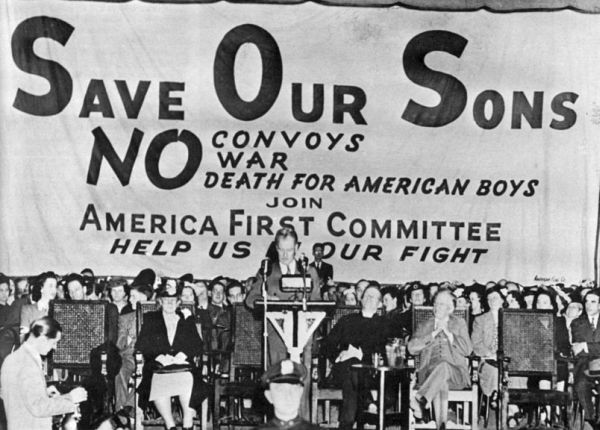 Meeting of the America First Committee, an organization uniting isolationists of all walks of life. Source: Public domain.
Meeting of the America First Committee, an organization uniting isolationists of all walks of life. Source: Public domain. British and American naval personnel, in the background three of the 50 American destroyers that were turned over to the British. Source: Library of Congress.
British and American naval personnel, in the background three of the 50 American destroyers that were turned over to the British. Source: Library of Congress.America at war
"Yesterday, December 7th, 1941, a date that will live in infamy," Roosevelt said. That day, the American naval base Pearl Harbor on the Hawaiian island of Oahu was attacked by the Japanese Imperial Navy. Over 2,000 Americans lost their lives and a large part of the American battle fleet in the Pacific was put out of action. During the previous months, political tension between the United States and Japan had intensified. Following the Japanese occupation of entire French Indochina in July 1941, the Americans had, just like the Allied countries, cancelled all export of oil to Japan. They demanded Japan should withdraw from China and French Indochina but instead, the Empire decided to cripple the American Pacific fleet with the attack on Pearl Harbor to prevent the United States from effectively opposing the Japanese expansion.
The day after, Roosevelt, who had called on the Japanese Emperor on December 6th to come to a peaceful solution of the conflict, addressed Congress in the Capitol. Millions of Americans listened to his speech that was being broadcast live on radio. The President condemned the "surprise, deliberate and dastardly" Japanese attack and asked the joint session of senators and representatives to support him in declaring war against Japan. The House of Representatives supported him with 388 against 1 and the Senate with 82 against 0. Following the declaration of war by Japan’s allies Germany and Italy on December 9th and 11th respectively, Roosevelt declared war on those countries as well, on the same day and by the same overwhelming majority in Congress. The United States entered the Allied camp.
"Today we are, along with you and the peoples of the British Empire, in the same boat. But it is a ship that cannot and shall not sink." Roosevelt wrote those words to his British ally Winston Churchill after the declaration of war. The two world leaders met again in Washington at the Arcadia conference of December 22nd to January 14th, 1942. Churchill stayed with the Roosevelt’s in the White House, further strengthening the friendly relations between the two men. At the conference it was decided that the defeat of Nazi Germany, considered to be the strongest enemy, should take priority. Only after Hitler had been defeated, the Allies would focus on the battle against Japan. Part of this so-called Europe First strategy would be an Allied landing in western Europe but it was agreed to launch an attack on the German and Italian troops in North-Africa first which would later (November 1942) become known as Operation Torch. In order to better coordinate the struggle, the Combined Chiefs of Staff was formed, consisting of the American and British Chiefs of Staff with its headquarters in Washington.
Apart from being president, Roosevelt also was supreme commander of the American armed forces but contrary to his allies, Churchill and Soviet dictator Joseph V. Stalin (Bio Stalin), he did not involve himself actively in military organization and strategy. He left that to his military commanders. His most important military advisor and confidant was George C. Marshall, Chief of Staff of the army who would be promoted to General of the Army (5 star general) on December 16th, 1944, the highest rank in the American armed forces. Marshall was a great advocate of an Allied landing on the French coast from Britain and who would have liked very much to have it launched in 1942. Stalin also wished his allies would soon make a Channel crossing, hoping that a war on two fronts in Europe would weaken Germany. The British however took the view that 1942 was too early yet for a crossing. It would remain a dispute between the Allies for months on end whereby Roosevelt stepped in as mediator between the British and the Soviets.
An additional result of the Japanese attack on the United States was the internment of over 110.000 persons of Japanese descent living on the West coast. It was feared that they were acting as spies for the Japanese Empire and supporting the Japanese cause. During the attack on Pearl Harbor, three locals of Japanese descent on the Hawaiian island of Niíhau had helped a Japanese pilot who had landed there after the attack on the naval base, which had also fueled this mistrust. With the signing of Executive Order 9066 on February 19th, 1942, enabling the evacuation of some or all citizens from military zones in the U.S., Roosevelt gave the green light for the massive internment. 62% of the people with a Japanese background thus interned were American nationals. Although the conditions in the War Relocation Centers were fairly good in general, Roosevelt’s reputation was tarnished by this episode as people blamed him for having robbed innocent people of their freedom for a long time without any form of trial.
Definitielijst
- Nazi
- Abbreviation of a national socialist.
- strategy
- Art of warfare, the way in which war should be conducted in general.
Images
Campaign in North-Africa and Italy
Between June 19th and 25th, 1942, a hastily called Second Washington Conference was held between Roosevelt and Churchill. At the time of the meeting the British 8th Army suffered a serious defeat in North-Africa after the Libyan port of Tobruk had been captured by the German Afrika Korps, commanded by General der Panzertruppe Erwin Rommel (Bio Rommel). The German general reported having taken 45,000 prisoners and destroyed over 1,000 tanks. Churchill asked Roosevelt for help. He sent additional war material to the British in North-Africa, including Sherman tanks and appointed Dwight D. Eisenhower (Bio Eisenhower) Commander-in-Chief of the landing in North-Africa (Operation Torch) that was launched November 8th, 1942. For the first time in World War Two, American ground forces were deployed at the front. The Allies focused on Algeria and Morocco which were ruled by the Vichy French government and collaborated with the Germans. As early as November 16th, these French colonies were conquered by the Allies.
As the Allies had gained a foothold in North-Africa, Churchill wished to launch a second campaign in Italy, starting with the invasion of Sardinia and Sicily. Although both the American military command and Stalin advocated a speedy Channel crossing, Churchill and Roosevelt decided at the Casablanca conference of January 14th to 24th 1943, to commence preparations for Operation Husky, the Allied invasion of Sicily. The aim was to eliminate Italy from the battlefield as soon as possible. They postponed Operation Roundup, the temporary name of the Allied landings in Western-Europe, to a later date in 1943. Stalin was angry about the delay of the Channel crossing but was not present in Casablanca himself to voice his comments on this. He had failed to turn up because he did want to leave the front (in particular the still raging battle for Stalingrad). Two French generals were present however: Charles de Gaulle (Bio De Gaulle), the leader of the Free French and Henri Giraud who had previously served under the Vichy French government and had meanwhile been named commander of the French troops in Africa by the Allies. The two Frenchmen could not stand each other but were forced by Roosevelt and Churchill to solve their disputes and shake hands.
The Casablanca Conference offered Roosevelt an opportunity to visit American troops in North-Africa. He was the first American president since Abraham Lincoln to do so. At home he would frequently leave Washington to pay a surprise visit to military training camps. In order to encourage workers, he regularly showed up in factories that had been incorporated in his Victory Program, in other words, a plan to have, among other things, 125,000 aircraft and 75,000 tanks roll off the assembly lines in 1943. First Lady Eleanor Roosevelt was far from idle during the war either and would visit American troops all over the world, including Australia, England and New Zealand. For security reasons, she traveled under the alias Rover. In particular injured American soldiers were being paid special attention by her. The devoted and compassionate president’s wife played her role brilliantly. Being the eyes and ears of her husband, limited in his freedom of movement as he was by his handicap, she fulfilled an indispensable role.
As the last German troops in North-Africa surrendered on May 13th, 1943 in Tunisia, the Third Washington Conference, codenamed Trident, convened in Washington from May 12th to 27th . Churchill and Roosevelt decided, again to the dissatisfaction of Stalin and George Marshall, to postpone the Channel crossing to 1944. First, the Allies would concentrate on eliminating Italy as a German ally. Operation Husky, the invasion of Sicily on July 10th, 1943 was the start of the Allied campaign aimed at the conquest of Italy. On August 17th, the Mediterranean island fell in Allied hands. The same day, Roosevelt and Churchill met again, this time in Quebec, Canada. During this top secret meeting, codenamed Quadrant lasting until August 24th , it was decided to step up the bombing of Germany in preparation of the Allied landing in Normandy that would henceforth be called Overlord instead of Roundup.
During their meeting in Quebec, the two world leaders also agreed to extend the co-operation between the United States and Great Britain in the development of the nuclear bomb. Roosevelt had established the S-1 Uranium Committee as early as 1939, after he having received a letter from physicist Albert Einstein, warning about the German nuclear program. In 1942, the committee would evolve into the Manhattan Project, the codename for the development of a nuclear weapon by the Americans, supported by the British and Canadians. Roosevelt would not live to see the deployment of the nuclear bomb however as he had already passed away when in August 1945 the Japanese cities of Hiroshima and Nagasaki were subjected to a nuclear attack with devastating results.
Definitielijst
- Casablanca conference
- Conference between the leaders of Great Britain and the USA (Churchill and Roosevelt). The conference took place from 14 to 24 January 1943.
- invasion
- Armed incursion.
- Manhattan Project
- The American development of the Atomic bomb during World War Two.
- Nagasaki
- Japanese city on which the United States dropped the second atomic bomb on 9 August 1945.
- Tobruk
- Small bunker. Usually manned by one soldier with a machinegun, but there were also bigger tobruks equipped with a canon or mortar.
Images
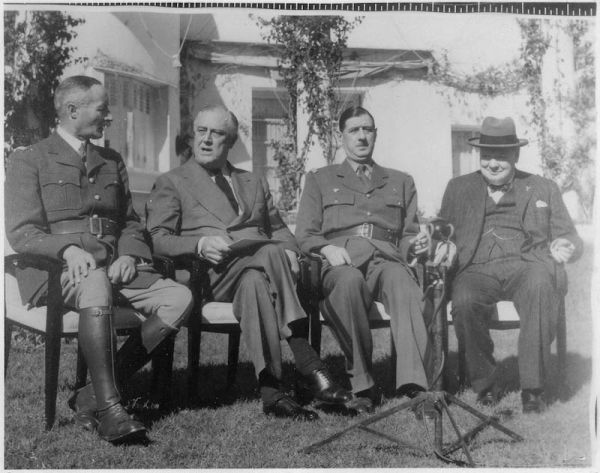 Roosevelt and Churchill during the de Casablanca Conferentie with the French generals Henri Giraud (left) and Charles de Gaulle ( in between Churchill and Roosevelt). Source: FDR Presidential Library & Museum.
Roosevelt and Churchill during the de Casablanca Conferentie with the French generals Henri Giraud (left) and Charles de Gaulle ( in between Churchill and Roosevelt). Source: FDR Presidential Library & Museum.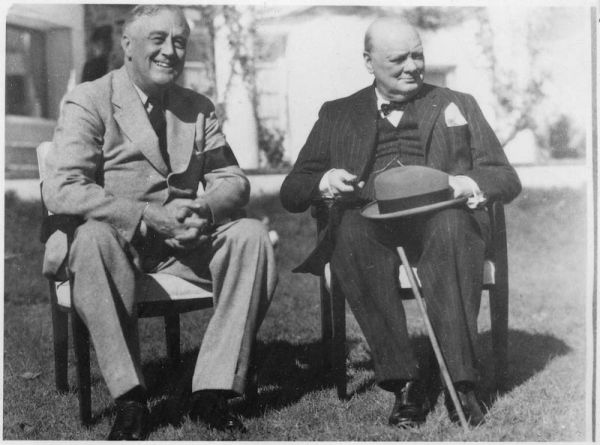 Roosevelt and Churchill, likewise during the Casablanca Conferentie. Source: FDR Presidential Library & Museum.
Roosevelt and Churchill, likewise during the Casablanca Conferentie. Source: FDR Presidential Library & Museum.The Big Three and Operation Overlord
After the Allies had started their campaign on the Italian mainland in early September 1943, Roosevelt and Churchill met between November 22nd and 26th , 1943, in Cairo during a conference codenamed Sextant. The Chinese nationalistic leader Chang Kai-Chek was also present which was the reason for Stalin’s absence for the Soviet Union was not at war with China and contact between Stalin and Chang Kai-Chek could have a negative influence in Tokyo. The post war partition of southeastern Asia was discussed and it was stipulated that all annexations by Japan since World War One had to be reversed. Two days after the Cairo conference, Roosevelt met his Soviet ally for the first time in Teheran on the first day of the Eureka conference, which lasted from November 28th to December 1st 1943 and held at the Soviet Embassy. It was the first time the Big Three met. When Stalin saw his American colleague for the first time, he is said to have been embarrassed about his handicap. The silence in America about the president’s paralysis also had its effect outside the United States. Stalin and Roosevelt met personally prior to the official negotiations, much to Churchill’s dissatisfaction as he felt to have been left out.
Roosevelt got along very well with Stalin also, despite the big political differences between the ruthless dictator and the humane, liberal democrat. Developing a good relationship with Stalin was an important goal for the American president as he hoped for Soviet support in defeating Japan once Germany was defeated. The meeting was to determine the future of Europe. Stalin and Churchill laid down the borders of postwar Europe and it was decided that the Polish frontier should be moved west to enable Stalin to keep the eastern part of Poland he had conquered in 1939. Although this went against Roosevelt’s Atlantic Charter, which promised all peoples the right of self-determination and demanded that territorial changes had to be approved by all parties concerned, Roosevelt acceeded. He showed himself a shrewd politician however, demanding that this agreement would be kept secret temporarily as he did not wish, with presidential election approaching, to alienate the millions of Americans of Polish descent.
In addition to Eastern Poland, Eastern Prussia, the Baltic States and Bessarabia would be turned over to the Soviet Union as well. In contrast to Churchill, who mistrusted Stalin, Roosevelt did not bother about expansion of communist territory yet. Later, when relations between the Americans and Soviets had chilled during the Cold War, Roosevelt would be blamed posthumously for having been so compliant to the Soviets. He did manage to assure himself of Soviet support however in defeating Japan once Germany had been conquered. During the Teheran Conference, it was further decided that the Allies would land in Normandy in May, although Churchill strongly preferred to increase the war effort in the Mediterranean. Stalin would coordinate the operations of the Red Army with Overlord and promised to declare war on Japan 90 days after the defeat of Germany; he also backed Roosevelt’s proposal to establish the United Nations. Roosevelt was satisfied with the outcome of the conference which he called a historic event and he praised the harmonious cooperation between the Allies.
In December, Roosevelt and Churchill met again in Cairo and again without Stalin. This Second Cairo Conference was held from December 4th to 6th, 1943. The Turkish president, İsmet İnönü was present as well but Roosevelt and Churchill failed in their attempts to have Turkey join the Allies. Turkey joined as late as February 23rd, 1945. Also in Cairo, Dwight Eisenhower (Bio Eisenhower) was named commander of Operation Overlord. The Allied landing would finally take place on June 6th, 1944 after a few postponements. The day before (June 5th), in a fireside chat, Roosevelt had told the American people about the Allied conquest of Rome on June 4th but he kept silent about the still secret Normandy landings. On the evening of the 6th, the devout president, member of the Episcopal Church offered a prayer to God on radio in order to give the soldiers oversea the strength to defeat Nazi Germany. He prayed for a world of unity and peace in which everyone could live in freedom.
Shortly after the Normandy invasion, President Roosevelt managed to have a law passed on June 22nd, that would be of great importance to those soldiers who would return to the United States alive. This so-called Servicemen Readjustment Act, better known as the G.I. Bill, assured the war veteran of a social network which provided for free schooling, a one-year unemployment allowance, a compensation for medical expenditures, a pension, a low mortgage and a low rent loan to start a private enterprise, etc.
Definitielijst
- invasion
- Armed incursion.
- Nazi
- Abbreviation of a national socialist.
- Red Army
- Army of the Soviet Union.
- Soviet Union
- Soviet Russia, alternative name for the USSR.
Images
The final year of his life
The heavy responsibilities of presidency in times of war exacted a visible toll of Roosevelt. In pictures and movies of the last year of his life, he looks ashen and pitiless. The charming, happy campaigner of pre war times had changed into an exhausted, worried old man. In 1944, his physician had diagnosed him with high blood pressure and a cardiac rhythm disorder. Exhaustion, loss of weight and a loss of muscle power, in combination with his handicap, made it hard to fulfill his daily duties. Notwithstanding, he kept on going and he considered it his duty to continue his presidency until Germany and Japan were defeated. His strong desire to establish an international organization for maintaining peace also motivated him to carry on. In public, he kept silent about his weak health and he sought diversion with Lucy Mercer, his lover of many years whose husband had passed away in 1944. He used his daughter to arrange meetings with Lucy without Eleanor finding out.
Even though the Normandy invasion had put the issue of opening a front in western Europe to rest, more and more arguments gradually arose among the Allies. While Roosevelt still considered Stalin a useful ally in the struggle against Japan after victory over Germany, Churchill feared Communist influence in a post war Europe. Operation Dragoon, the Allied invasion of southern France on August 15th, 1944, was against the will of the British Prime Minister whose preference had been to launch an attack on the Balkans where the German got their oil supplies from. By liberating the Balkans, Churchill also wished to prevent this region from falling in the hands of the Red Army. For the same reason, Churchill was an advocate of supporting the Polish nationalists during the Warsaw uprising which had started on August 1st. Stalin refused to come to the aid of the Polish and Roosevelt kept out of it. When the Soviet leader finally permitted American aircraft to drop weapons over the Polish capital from Soviet bases, the battle had already been decided in favor of the Germans.
Roosevelt talked to Churchill again from September 12th to 16th at the Second Quebec Conference, codenamed Octagon. Stalin did not attend. The main theme on the agenda was the future of Germany. Roosevelt advocated implementing the plan, drafted by his Secretary of Finance, Henry Morgenthau, to divide post war Germany in regions and reduce them to an agricultural area without any influence on global politics. The reasoning behind it was that a severely weakened Germany would never be able to start a new war anymore. After some discussion, Churchill acceeded but after the revengeful plan had been severely criticized by American politicians and the press after the conference, Roosevelt rejected it anyway. The fact that he had not immediately taken his distance from a plan, unjust in many eyes, which was diametrically opposed his Atlantic Charter and would have imposed a low standard of living on million of innocent people leads to the assumption that the weakened president had lost his political punch.
November 7th, 1944 was election day again in the United States. Roosevelt had announced his candidacy for a fourth term in July with Harry S. Truman, a moderate senator from Missouri as his running mate because vice-President Henry A. Wallace was considered unpredictable and too much of a leftist by influential, more conservative circles within the Democratic party. The incumbent president challenged Republican Thomas Dewey, Governor of the state of New York. Roosevelt promised to take a strong stand for a Second Bill of Rights after the war, a supplement to the ten amendments of the Constitution that was to provide for the right of work, reasonable wages, medical care, housing, social security and schooling. Roosevelt was re-elected but this time the difference in numbers was smaller; 25,6 million against 22 million. The Democrats maintained their majority in Congress. The inauguration of January 20th, 1945 was a scanty affair, owing to the war and Roosevelt’s health and took place on the south porch of the White House. The customary parade and festivities were canceled.
Exhausted by the election campaign, Roosevelt retired to his cottage in Warm Springs. There could be no long rest however as another meeting with Churchill was on the agenda, this time on Malta from January 30th to February 2nd, 1945, in preparation of the conference with Stalin at Yalta in the Crimea. Poland remained the most important obstacle between the Americans and the British on the one hand and the Soviets on the other. The Anglo-Saxon countries supported the Polish government-in-exile in London while Stalin dominated the Soviet oriented provisional government that had been established in Lublin as of August 1944. During the Yalta conference, which was held from February 4th to 11th, 1945, the post war political relations in Europe were being discussed mainly. Germany would be divided into zones of occupation and it was agreed that democratic governments were to be set up in liberated countries. The decision to call a conference in San Francisco, to be held on April 25th and the establishment of a global organization, Roosevelt had wanted for so long, was a victory for him.
In practice, Stalin proved not to adhere to the agreements reached in Yalta about post war Europe. In the countries, liberated by the Red Army, the Soviet dictator would establish puppet governments loyal to Moscow. That for instance was the case in Poland were the Lublin government was set up by Stalin. The Polish government-in-exile stayed behind empty handed and members of the Polish Home Army, who had fought against the occupying forces, were arrested in droves by the NKVD, the Soviet security service. The nationalist warriors were considered enemies of Communism and henchmen of the West. Right up to his death, Roosevelt sent letters to Stalin urging him to adhere to the agreements reached at Yalta but to no avail. The seeds of the Cold War, during which Eastern Europe would be dominated by the Soviet Union for decades, had been sown.
Definitielijst
- Communism
- Political ideology originating from the work of Karl Marx “Das Kapital” written in 1848 as a reaction to the so-called class struggle between the proletariat (labourers) and the bourgeoisie. According to Marx the proletariat would take over power from the well-to-do classes though a revolution. The communist movement aspires an ideal situation where the means of production and the means of consumption are common property of all citizens. This should end poverty and inequality (communis = common).
- invasion
- Armed incursion.
- Red Army
- Army of the Soviet Union.
- Soviet Union
- Soviet Russia, alternative name for the USSR.
Images
His demise and commemoration
The travels to and from Yalta and the intensive negotiations had exacted the utmost of the weakened president. For the first time in office, he addressed Congress on March 1st, 1945, sitting down while he reported on the results of the Yalta Conference. During this address, he spoke about his handicap, which he had rarely done before. "I hope you will excuse me for this unusual pose," he said, "but I know you will understand it is a lot easier for me not to drag 10 pounds of steel on my lower legs around." A few weeks later, April 12th, 1945, 63 year old Franklin Roosevelt expelled his last breath while he was staying in his cottage at Warm Springs. According to the official records, he died of a stroke. A spicy detail: he died in the presence of his mistress Lucy Mercer. Artisan Elisabeth Shoumatoff, a friend of Lucy’s, was there as well to paint a portrait of Roosevelt; the famous unfinished painting is on display at Warm Springs. It was a severe blow for Eleanor Roosevelt when she found out her husband still saw Lucy and that their daughter had even arranged the meetings between her father and his mistress.
On April 13th, Roosevelt’s remains were transferred by presidential train and escorted by 2,000 servicemen from Fort Benning to Washington in a coffin covered by the flag. Americans were lining the tracks to mourn the death of their beloved president. He had made life bearable for them again during the Great Depression. Many a living room of less well to do Americans had his portrait on the wall. On April 14th, the train carrying Roosevelt’s remains arrived in Washington. The same day, the coffin was taken to the east wing of the White House. After the funeral service, the coffin was taken to Roosevelt’s estate Springwood in Hyde Park, again by train. Escorted by a military band and a battalion of West Point cadets, the coffin was taken on a gun carriage to the rose garden, Roosevelt’s final resting place. Numerous Americans were present at the burial ceremony. As the coffin was being lowered, the last tribute was paid to the American president with three salutes. Various world leaders would visit the burial site. On March 12th, 1946, almost a year after Roosevelt’s death, Churchill paid a visit to the grave of his friend and ally. He was accompanied by the president’s widow who would later be buried at the same spot just as Roosevelt’s beloved dog by the way, the Scots terrier Fala.
Comparative research into the functioning of American presidents, conducted by The Wall Street Journal and The Times, show Franklin Roosevelt usually ending up in the top three. He was no dull policy maker nor a stern guardian of the treasure chest but an iconic figure of comparable stature to his predecessors George Washington and Abraham Lincoln. He did not allow himself to be led by Congress but used the democratic institute to achieve his own goals without being deterred by the politic opposition he faced. His New Deal was revolutionary and formed a strong foundation of a society in which an important role is allocated to the government to support citizens in illness, old age and unemployment. Later presidents continued his work, for instance Barack Obama who achieved health insurance for all, despite strong Republican opposition.
Except for having been the president who led America through the Great Depression, Roosevelt also stood at the base of the United States as a world power. On May 8th, 1945, shortly after he had passed away, the war in Europe and Nazi Germany came to an end. His successor, Harry Truman, was in fact unprepared for the job he took over. As a senator, he had distinguished himself in the background in fighting corruption in the war industry. It was this inexperienced politician who gave the order for the nuclear attack on the Japanese cities of Hiroshima and Nagasaki, causing Japan to surrender. Roosevelt’s support to the British and Soviets, prior to America’s entry into the war and his good relations with Churchill and Stalin had played a crucial role in the victory of the Allies. The American president dragged his country out of isolationism and he was the driving force behind the United Nations, the organization he had been dreaming of and which was established October 24th, 1945. Partly through the UN, America would exert its influence on global politics up until today.
After the death of her husband, Eleanor still faced a brilliant future. President Truman appointed her in the American delegation to the UN where she, as staunch advocate of human rights, would be appointed chairwoman of the Commission on Human Rights. Inspired by the Four Freedoms, formulated by het husband, she was the driving force behind the Universal Declaration of Human Rights that would be accepted by the plenary session of the UN on December 10th, 1948. After an interruption during the presidency of Republican Dwight D. Eisenhower from 1953 to 1961, Democratic president John F. Kennedy appointed her again in the American delegation to the UN. She would hold this position until 1962. The same president appointed her, staunch advocate of women’s rights as she was, chairwoman of the presidential committee on the position of women. During her post war career, she traveled to the Soviet Union a few times where she talked with Soviet leader Nikita Chruchev and in doing so contributed to the relationship between the two countries during the Cold War. On November 7th, 1962, she passed away in her home in New York, the president’s widow who gave splendor to the role of First Lady but who also played an unforgettable role in world politics without her husband.
Since 1945, the Roosevelt estate is national heritage where the presidential library and museum are sited. Another location in the U.S. where tribute is paid to the former president is the Franklin Delano Roosevelt Memorial in Washington DC, 358,7 square yards and opened by president Bill Clinton in 1977. There are various statues in the grounds of the memorial site, for instance one of the president with his dog Fala and another one of him in his wheelchair.
Franklin Roosevelt is also publicly commemorated outside the United States. In 1948 in London, a statue of his was unveiled in Grosvenor Square in the presence of his widow. In the Netherlands, the origin of the Roosevelt family, the president has not been forgotten either. Since 1982, the Roosevelt Foundation in Middelburg awards the Four Freedoms Award in even years to those who have made efforts to promote the four freedoms, formulated by Roosevelt in 1941. The same is done in odd years by the Franklin & Eleanor Roosevelt Institute in New York. People like Harry Truman, Princess Juliana, John F. Kennedy and Nelson Mandela have been honored with this award.
Definitielijst
- isolationism
- US policy not to interfere with foreign affairs. This policy lasted more or less until the attack on Pearl Harbor (December 1941).
- Nagasaki
- Japanese city on which the United States dropped the second atomic bomb on 9 August 1945.
- Nazi
- Abbreviation of a national socialist.
- Soviet Union
- Soviet Russia, alternative name for the USSR.
Images
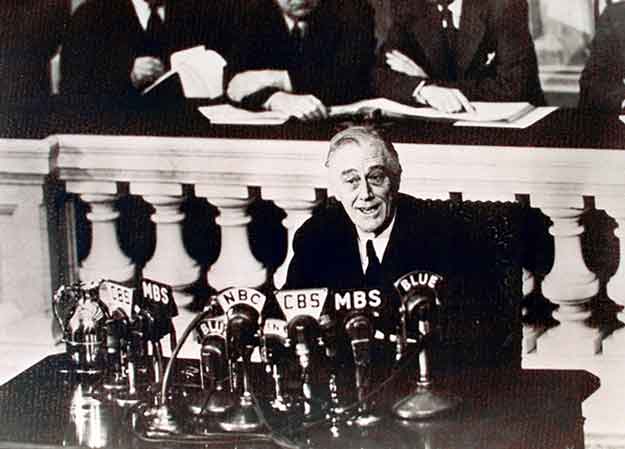 A very weak Roosevelt addresses Congres, March1st, 1945, for the first time sitting down. Source: FDR Presidential Library & Museum.
A very weak Roosevelt addresses Congres, March1st, 1945, for the first time sitting down. Source: FDR Presidential Library & Museum. The unfinished portrait of President Roosevelt by artisan Elizabeth Shoumatoff. Source: FDR Presidential Library & Museum.
The unfinished portrait of President Roosevelt by artisan Elizabeth Shoumatoff. Source: FDR Presidential Library & Museum.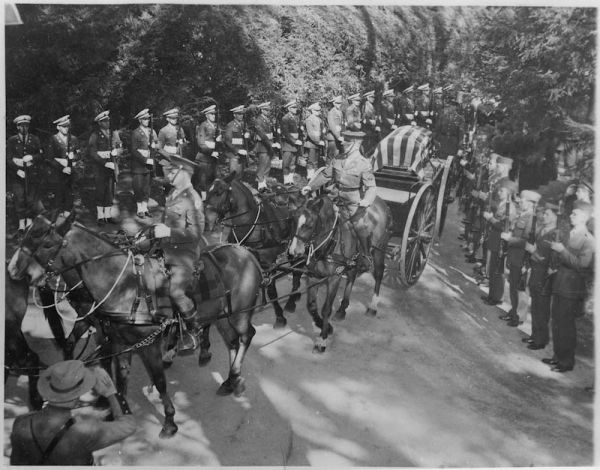 The coffin containing Franklin Roosevelt’s body arrives in Hyde Park, the birthplace and final restingplace of the President. Source: FDR Presidential Library & Museum.
The coffin containing Franklin Roosevelt’s body arrives in Hyde Park, the birthplace and final restingplace of the President. Source: FDR Presidential Library & Museum.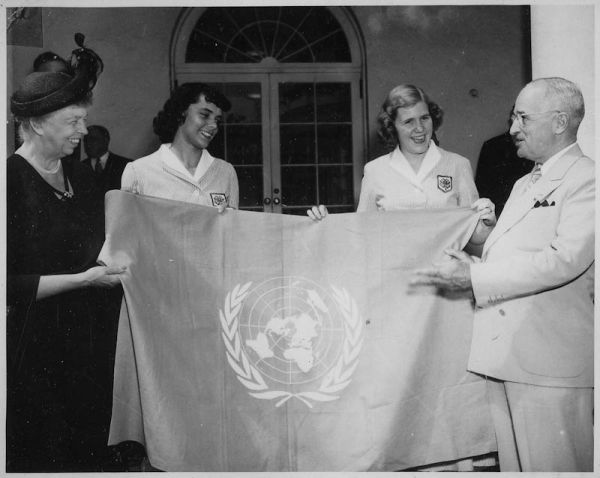 After the death of her husband, Eleanor still played an important role on the international stage. Here she presents the flag of the UN to Harry Truman, who succeeded her husband as president. Source: FDR Presidential Library & Museum.
After the death of her husband, Eleanor still played an important role on the international stage. Here she presents the flag of the UN to Harry Truman, who succeeded her husband as president. Source: FDR Presidential Library & Museum.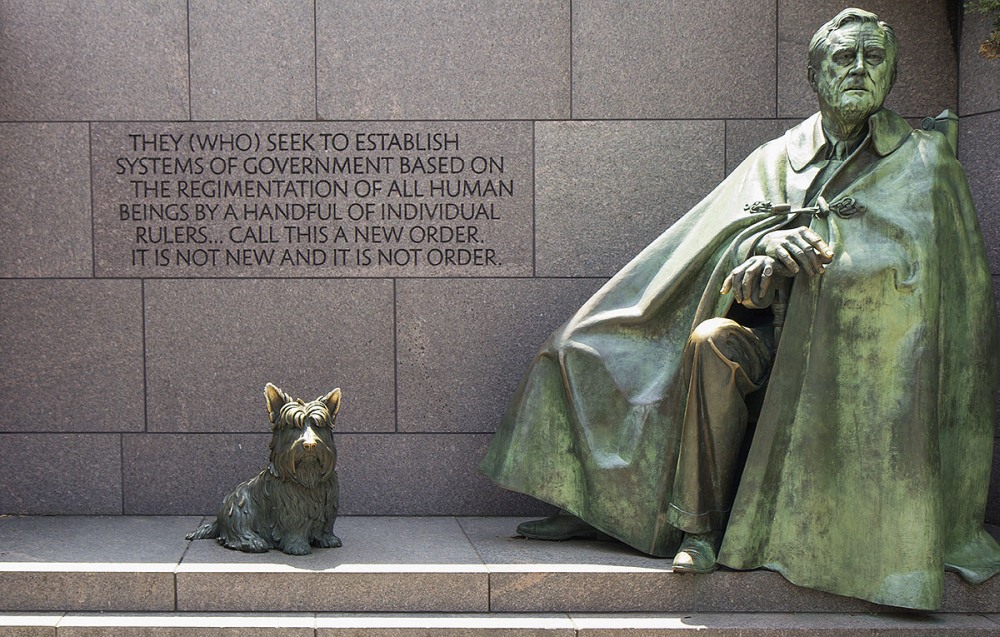 The statue of Franklin Roosevelt with his favorite dog Fala in Washington D.C. Source: Stefan Fussan / Wikimedia Commons.
The statue of Franklin Roosevelt with his favorite dog Fala in Washington D.C. Source: Stefan Fussan / Wikimedia Commons.Information
- Article by:
- Kevin Prenger
- Translated by:
- Arnold Palthe
- Published on:
- 19-01-2025
- Feedback?
- Send it!
Related sights
Related books
Sources
- Bericht van de Tweede Wereldoorlog, Amsterdam Boek, Amsterdam, 1970.
- BARTAIRE, I., Franklin Roosevelt: wereldleider in oorlog en vrede, Davidsfonds, Leuven, 2011.
- BOUWMEESTER, C. e.a., Kroniek van de 20ste eeuw, Elsevier, Amsterdam, 1985.
- COKER, J.W., Franklin D. Roosevelt: A Biography, Abc-Clio, Santa Barbara, 2010.
- KEEGAN, J., Who's who in World War Two, Routledge, Londen, 2002.
- MAK, G., Reizen zonder John, Atlas Contact, Amsterdam, 2012.
- ROMPUY, H. VAN, Franklin Delano Roosevelt: grondlegger van een wereldmacht, Garant, Antwerpen / Apeldoorn, 2008.
- ROSSEM, M. VAN, De Verenigde Staten in de twintigste eeuw, Sdu Uitgevers, Den Haag, 2001.
- ROSSEM, M. VAN, Drie oorlogen, Historisch Nieuwsblad, Utrecht, 2007.
- VERHAGEN, F., Van George Washington tot Barack Obama, Veen Media, Utrecht, 2012.
- amhistory.si.edu
- www.britannica.com
- en.wikipedia.org
- www.fdrlibrary.marist.edu
- Nederlands Legermuseum
- www.history.com
- www.judiciary.senate.gov
- www.law.columbia.edu
- www.nps.gov
- www.pbs.org
- www.ushmm.org
- www.whitehouse.gov
- irma.nps.gov/Stats
- Thanks to Robert Jan Noks, Annabel Verwer, Sebastiaan Vonk and Ed Woertman for the necessary corrections and useful suggestions.
